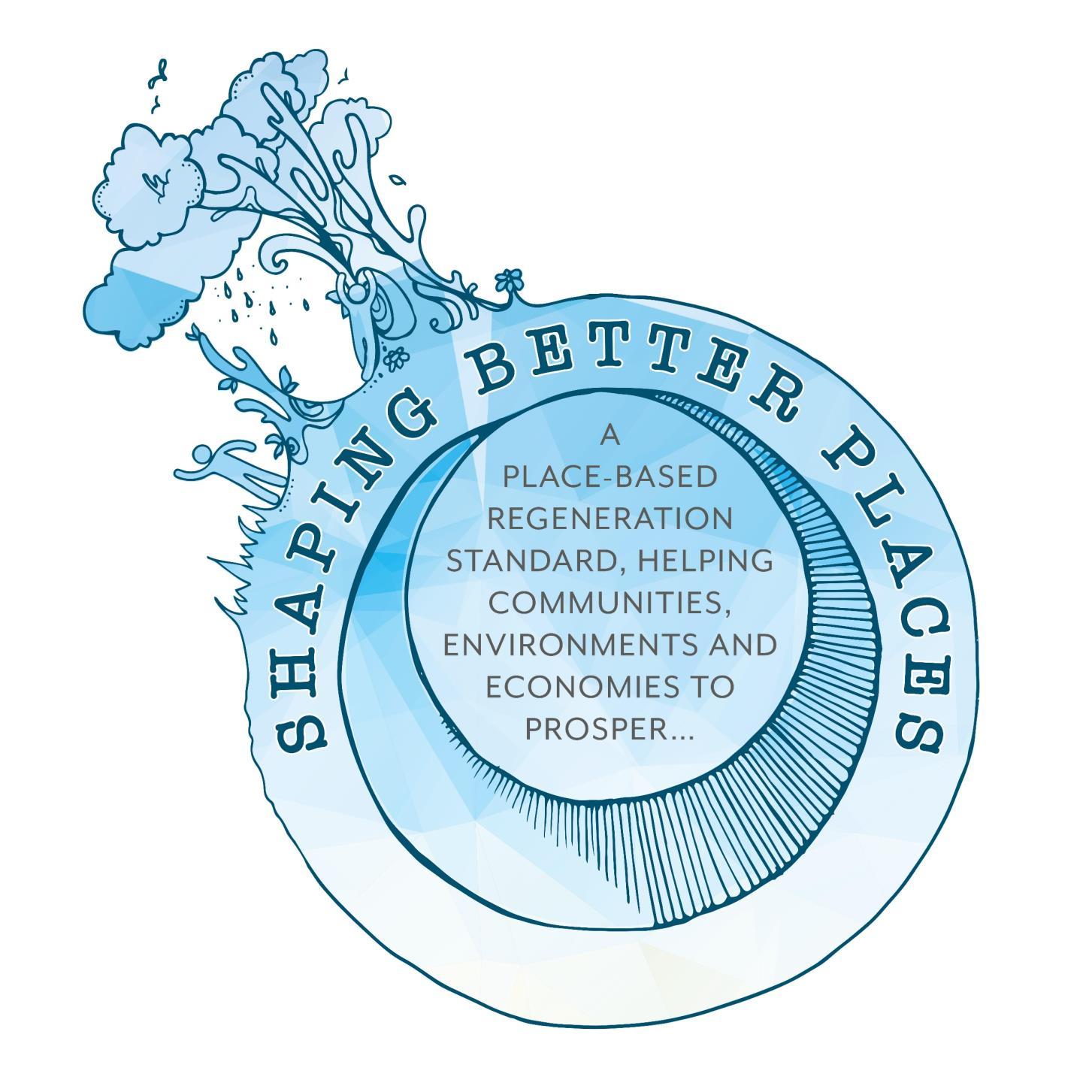










Arc has been commissioned to prepare a Place Plan for the parishes of Cowes and Northwood. The objective is to provide a menu of actions for positive change consistent with the lived experience of local people, the aspirations of local businesses and organizations, and the strategic context provided by local plans and policies. The methodology for the work is a combination of literature review, online questionnaire (The Place Standard), social media comment; feedback through local events, zoom meetings with stakeholder organizations, and other correspondence. The Covid pandemic, and the consequent restrictions on public meeting, have inevitably constrained the process of data collection and community engagement, but the key themes and proposals for action are based on a robust assessment of consensus derived from all sources.
The Place Plan provides content to support local decision-making, project development and community action. The recommendations and action plan form part of that resource but are not intended to be definitive or final. The whole document is designed as a workbook that can be amended, adapted, altered and rearranged to support the efforts of local organizations in shaping positive change.
National Data
The Place Plan is derived from a hierarchy of publicly available data sets and published information.
National data is sourced from the Office of National Statistics and UK Government departmental reports as they apply to the parishes of Northwood and Cowes
County data

County data is sourced primarily from the Isle of Wight Council Core Strategy (2012), the Draft Island Plan (2015 and 2019 consultations) and their supporting and technical documents and reports.
Parish data








Parish data comes from electoral ward and local super-output area information published by the Isle of Wight Council, local plans, policies and minutes published by the town and parish councils and other documents and reports considered and referred to in local governance and decision making.
Public and Stakeholder Comment
Public comments, opinions and suggestions are sourced from town and parish council consultations on budget and policy statements and work undertaken by and commissioned through the Isle of Wight Council Regeneration team as part of the ‘Wight We Want’ consultation.
Sources include the online Place Standard questionnaire, supplemented by online meetings with stakeholder organizations and limited public engagement.
The Place Plan identifies a set of strategic challenges faced by the communities of Cowes and Northwood, both shared and individual. The challenges and solutions proposed are organized around core elements of place-based regeneration:
Geographic and Demographic data Foundation Capital (Natural, Social, Cultural)









• Geography and Demography – the distribution and composition of the physical and human character of the project areas.
• Foundation Capital – the quantity, quality and ‘health’ of the natural, cultural and social components of Cowes and Northwood.
Local Land Use Policy
• Land Use Policy – the framework of international, national and local decision-making with regard to development and infrastructure.
Local Governance
• Governance – the role of local authorities at county and parish level and the network of organizations and institutions involved in the provision of public services and amenities.




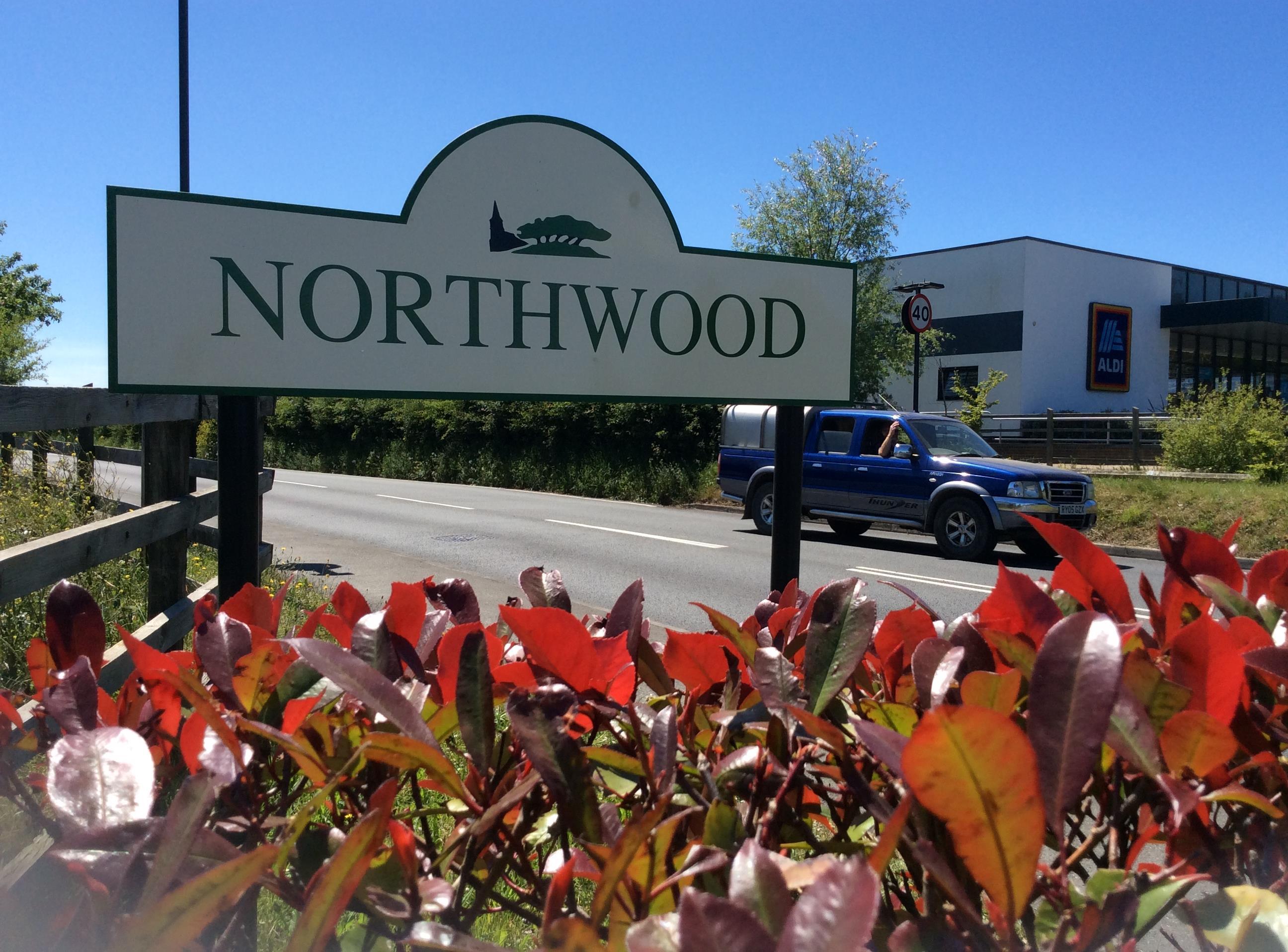
COWES
• Population 10,600
• Parish area 2.8 km²
• Population density 3800/km²
• 81 listed buildings
• £3.8M business rate tax base
• 3.7 km shoreline
• 2 primary schools of 260 and 430 pupils
1 secondary school of 1000 students
NORTHWOOD
• Population 2,400
• Parish area 5.5 km²
• Population density 420/km²
• 13 listed buildings
• £1M business rate tax base
• 2.1 km shoreline
• 1 primary school of 200 students
• 9 Ancient Woodlands
A Short Gazetteer

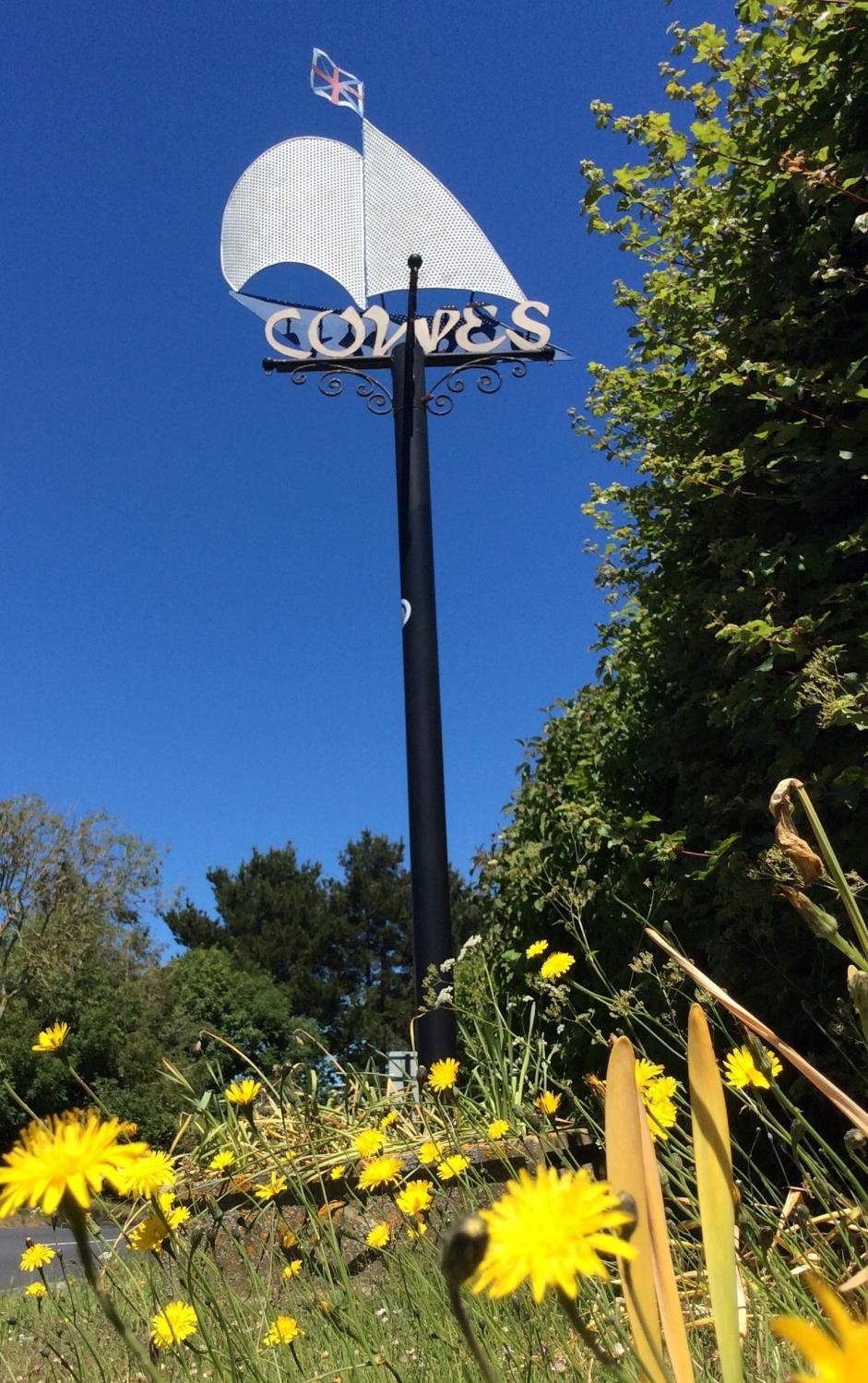
The Four 2021 Electoral Wards covered by the Place Plan





Cowes has spread inland from its harbour, encircling the central parks and infilling between local streets and roads. It has retained well-defined core public and community spaces, dominated by Northwood Park and connected greenspaces around Cowes Academy, golf course, IW Community Club and recreation ground, with a lively High Street and waterfront.
• There is a prominent socio-economic divide between the south-east and north-west areas of Cowes, the border running approximately from Mill Hill Road/Medina Road, to Three Gates Road/Seaview Road, with wealthier areas to the north.

Cowes Medina Ward broadly covers the south-eastern zone, and this is reflected in the Index of Multiple Deprivation for its component Lower Super Output Area (LSOA) units. Approximately 15% of homes in this area are social rented stock owned by affordable housing providers. This division can be seen in the pattern of other social and neighbourhood metrics such as second homes, AirBnB distribution and house sales and prices. It is important that this is recognised as part of the historic identity and character of Cowes, the signature of its unique combination of royal patronage and industrial employment, rather than as a problem to be fixed, with all of the risks of gentrification and exclusion that can follow.
• The main residential area of Northwood village today has come much later than its small and distinctive satellite communities of Somerton, Medham, Chawton (the original centre), Pallance and Hillis. Its evolution from ribbon development along through-roads has left it without a designed, functional civic infrastructure and particularly vulnerable to the impacts of increased traffic on Newport Road and Pallance Road.
• The separation of Cowes and Northwood along the line of Three Gates Road, including the cluster of business parks, whilst conserving settlement boundaries has inevitably distanced Northwood from facilities and services. Although politically connected within one ward there is a practical sense in which Northwood is adrift between Newport and Cowes.
• The two communities have significantly different relationships with green infrastructure. Cowes is well provided with accessible public and semi-public parks such as Northwood Park, Mornington Woods and Prince’s Green, but has little connection with extensive areas of natural space. Northwood has very little managed public open space but, as a parish, has a network of public rights of way, and a national cycleway, connecting with large woodlands, lowland farm landscape and undeveloped coast. However, access to these areas is made difficult by busy cross-cutting throughroads and few safe crossing points.
• Cowes and Northwood (and Gurnard) form a peninsular community, mirrored by East Cowes and Whippingham. A significant consequence of this is a greater risk of isolation when transport and travel arrangements are disrupted. At times during 2020, the individual and in-combination effects of Covid constraints, the re-engineering of the St. Mary’s junction, the inoperative chain ferry and assorted local road and utility works, significantly impacted the lives of a community of over 13,000 people.

(with Town Centres marked)

A North Medina ‘bloc’ is clearly visible within existing policy and strategy documents
Sample aggregate house price and sales over the last 7 years
Suggesting higher turnover of more expensive dwellings north of Baring Road and more stable residential community around Mill Hill Road and the estuary.
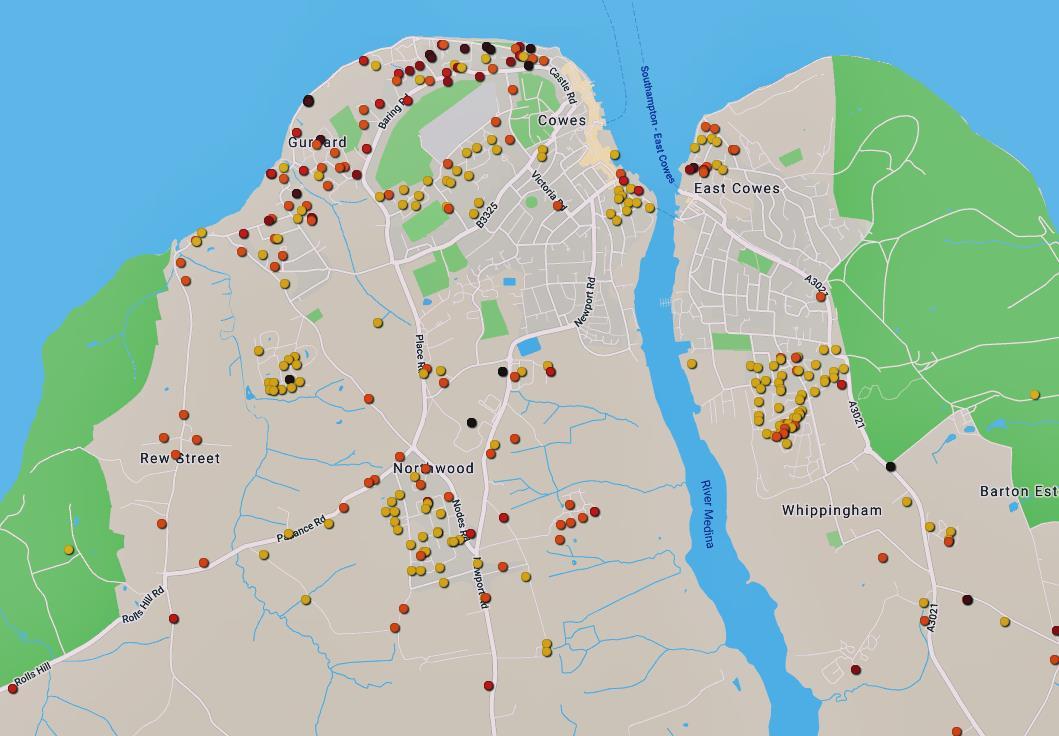
Index of Multiple Deprivation (IMD19)
(darker blue = higher level of deprivation),

Crime Breakdown 2018 – 2020 for Cowes, Northwood and Gurnard.

Summer peaks include annual Cowes Week spike marking a seasonal shift of crime maxima from south-west to north-east.

The work locations for residents of Cowes.
The predominant importance of Newport and East Cowes for commuting (both with very strong public transport options).

Location of Residents
Travelling to the Somerton P&R or Working in the Surrounding Area
The importance of the Park+Ride scheme for residents of Cowes

The distribution of hotel and B&B bed spaces on the Island.
Very low hotel bedspace numbers and average B&B levels.
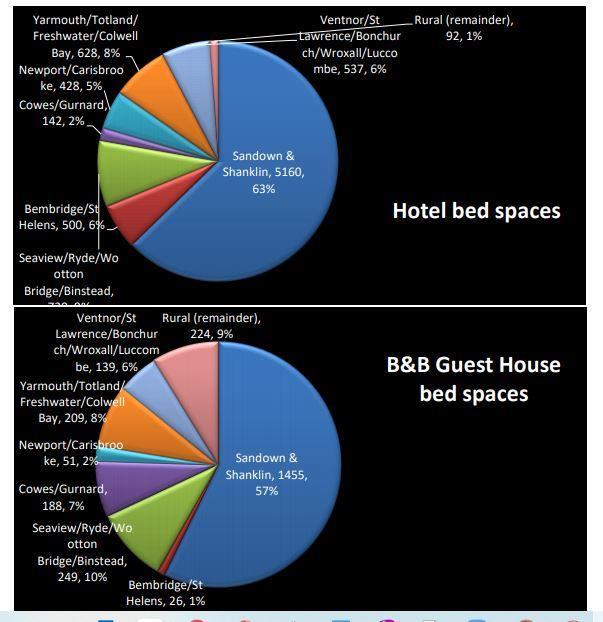
The distribution of pub bed spaces on the Island.
Very strong local provision fitting with ‘boutique’ character of the local tourism offer.

The social calendar of the project area is dominated by Cowes Week, and the programme of races and competitions that it headlines; the County Agricultural Show (the showground is in fact in Parkhurst and Hunnyhill ward but is closely associated with Northwood by proximity and by name), and the work of a revitalised Northwood House, including the IW Literary Festival. A growing addition to the headline events is the Noel Turner Science Festival, hosted by Cowes Enterprise College and managed by the Winchester Science Centre, attracting over 2500 students from Island schools over the two days of talks, demonstrations and displays.
The closure of the Isle of Wight Youth Activity Centre (IWYAC) in 2015 inevitably reduced affordable access to water sports. Participation in sailing continues to be promoted and supported by UKSA and a variety of smaller RYA training providers. The Cowes Town Waterfront Trust provides sponsorship and free or discounted services and premises to many local and visiting sailing groups, including the Miss Isle School of Sip-Puff Sailing founded by the remarkable quadriplegic sailor, Natasha Lambert. The Royal London Yacht Club provides bursaries through its Charitable Youth Trust, TheRoyalYachtSquadronIOWFoundation(RYSF) to help young people to get started in a career that has a maritime element. Cowes Corinthian Yacht Club hosts and supports the Cowes Sailability Club, providing recreational boating and sailing opportunities for adults and children with physical disabilities, learning difficulties and debilitating medical conditions.

The Classic Boat Museum (Classic Boat Centre Trust) provides an experience of local boatbuilding history, marine heritage and archaeology and is based in twin sites in Cowes and East Cowes. The Trust provides education and research facilities to the public, works with Island schools and Island's Museum Forum and is represented on the board of The Island Collection (the Isle of Wight cultural network).
• There is a rich menu of diverse local community and social activity delivered through a variety of smaller venues such as Cowes Library (valued very highly by local residents), the Beckford Centre (now part of the newly formed charity, the Cowes Heritage and Community Group), the IW Community Club, Northwood Village Hall and Trinity Theatre.
• There is an important cluster of youth-focussed outdoor activity and sport provision around the Place Road/Park Road junction, comprising the IW Community Club pitches and the recreation ground facilities. These are complemented by the recent establishment of the WightTricks Academy on Prospect Road, one of only 3 such teaching centres for tricking in the UK (a combination of gymnastics, martial arts and parkour).
• National cycleway 23 links Cowes to Newport and extends around the coast to Gurnard via local routes. The new England Coastal Path will overlay this coastal and riverside access.

One of the most striking characteristics of the Cowes and Northwood area is the predominance of civic, nonprofit and charitable stakeholders in the social, cultural and business life of the area, forming a key group of 15 or so anchor organizations.
• Northwood House, Cowes Harbour Commission, Cowes Town Waterfront Trust, Cowes Library, The Cowes Heritage and Community Group, Cowes Academy, Lanesend Primary School, Northwood Primary School, Cowes Medical Centre, Northwood Cemetery, IW Foodbank, as well as Cowes Town Council, Northwood Parish Council, Isle of Wight Council and the Solent Local Enterprise Partnership (Solent LEP) are all significantly active in the management and delivery of local public, community and commercial services.
• In contrast to other core population centres on the Island, Cowes can show an impressive list of important public and heritage land and buildings not only occupied but usefully engaged in the life of the town and wider North Medina community.
• Three of the area’s four schools are academies, Cowes Enterprise College is an Ormiston academy, Northwood and Lanesend Primary are ‘converter’ academies, and Cowes Primary is local authority maintained. 86% of pupils at school within the Place Plan area attend an academy.
• There is a significant deficit of accessible public open space in Northwood contrasting with its rural setting, surrounding farmland landscape and largely undeveloped riverside. Cowes has much greater coverage of greenspace (public and semi-public) within a densely urban setting. Its waterfront is distinctly split between a largely inaccessible harbour and an extensive northern esplanade.

Open Space (Isle of Wight Council 2010 Audit)
Significantly poorer provision in Northwood compared to Cowes

Local, Regional and National marked cycle routes.
The mapped provision includes on-road routes. There remains a lack of cycling infrastructure to support this indicative network.
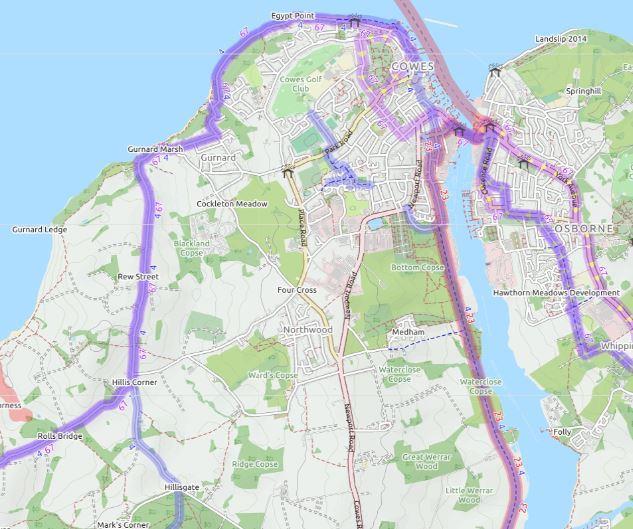
The first new National Trail in a decade, approximately 5km will follow the coast of Cowes and Northwood.

There are 6 levels of species and habitat protection in place in the parishes of Cowes and Northwood.
• Three are essentially coastal and estuarine, forming part of the wider Solent family of Marine Protected Areas:
• Special Area of Conservation (SAC), covering the whole of the shoreline, coastal waters and estuary within the project area. This designation protects wildlife habitats of international importance, in the case of Cowes and Northwood these are primarily subtidal and intertidal sand and mudflats.
• Special Protection Area (SPA), covering only mid-estuary areas and therefore restricted to Northwood. This designation focusses on habitats of international importance for birds, specifically waterbirds that pass through the area on migration and stay through the winter.
• Ramsar, covering the same areas as the SPA within the Place Plan area and adding support to the protection of wetlands of international importance.
Three are UK national and IW local designations:

• Site of Special Scientific Interest (SSSI), protecting terrestrial, freshwater and coastal habitats of national significance for their assemblages of important species. In the project area the Medina SSSI covers the same areas as the estuary SPA. There is also a small section of the Parkhurst Forest SSSI included within the Place Plan boundary. Both of these areas fall within Northwood parish only.
• Ancient Semi-Natural Woodland (ASNW), giving legal protection to woodlands that have persisted in the local landscape since 1600.
• Sites of Importance for Nature Conservation (SINC), determined by Isle of Wight Council, identify and protect habitats of local significance not otherwise protected in policy or law.
Special Area of Conservation (SAC)
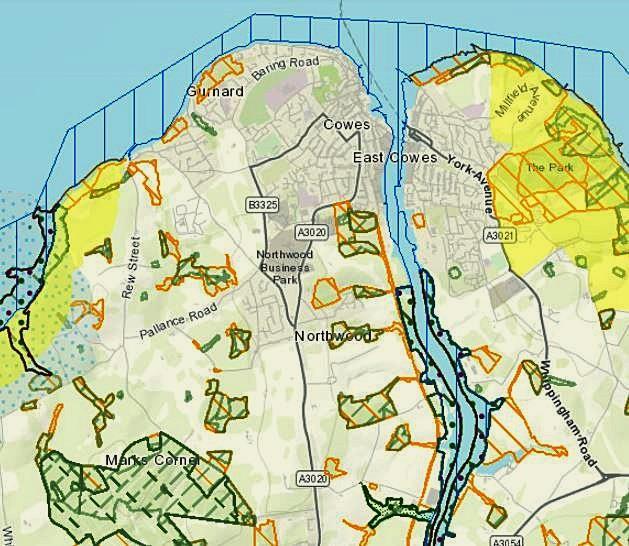
Special Protection Area (SPA)
Site of Importance for Nature Conservation (SINC)
Ramsar (International Wetland)
Site of Special Scientific Interest (SSSI)
Ancient Semi-natural Woodland (ASNW)
• There is a significant difference in the distribution of protected habitats between Cowes and Northwood parishes with a far higher concentration in the latter. Other than the SAC designation that covers the whole of the project shoreline in both parishes, Cowes has only part of one SINC (Princes Esplanade Wood C234A) whereas Northwood has 8 SINCs, 7 Ancient Woodlands, parts of 2 SSSIs, and sections of SPA and Ramsar.
• Tree Protection Orders (TPOs), and the related Woodland Orders and Area TPOs, are primarily intended to preserve ‘visual amenity’ rather than ecological value but often provide an incidental level of legal and policy protection to areas of tree cover useful to wildlife.

• TPOs are more densely designated in Cowes, reflecting the extent of the historic park and (built) conservation area within the parish when compared to the comparatively recent evolution of Northwood as a residential centre.
• Overall, these data suggest a more planned and managed landscape development in Cowes compared with the organic development of Northwood.
• Northwood Parish has stewardship of significantly greater natural capital than Cowes.
Tree Preservation Orders
Tree Protection Orders, showing designed parkland character in Cowes and the semi-natural woodland in Northwood
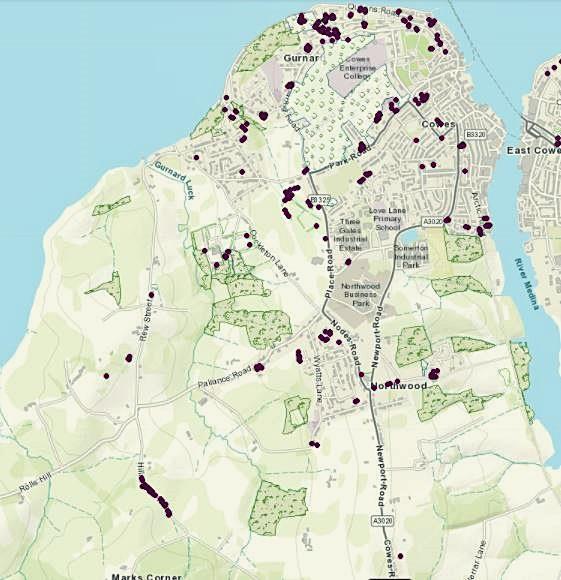
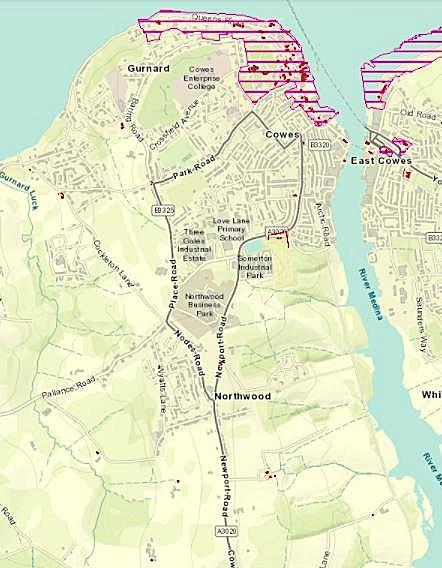
The 2004 Cowes Conservation Area Character Appraisal gives useful ‘pen portraits’ of the main features of heritage value,

• Northwood Park. This park on the hilltop is home to an elegant but now rather ‘sad’ house and its recently restored church. The open space has a tired feel to it, though the quality is still evident. Much of course has been done since that time to rectify the issues of neglect, particularly since the formation of the Northwood House Charitable Trust Company Ltd, in 2012.
• Queens Road: This is a varied but elegant residential area which has its roots in the early days of yacht racing in the Solent. The focus of the villas is the view over the water along with the facility to see and be seen on the promenade.
• Town Centre: This is the small scale, historic and lively centre of a town which is tied strongly to its waterfront and to waterborne activity in many forms. Its steep streets leading off the High Street afford views to the Solent and mainland.
The IW Historic Environment Action Plan, published in 2008, provides detailed information about the evolution of Cowes and Northwood. Some examples are quoted.

• Northwood Church was a chapel of Carisbrooke during the Middle Ages, becoming a parish church in the 16th century
• The small trading port of Cowes was established in early 17th century with houses and shops in West Cowes and warehouses in East Cowes. 17th century trade was mainly in tobacco and 18th century trade was in rice from Carolina
• From the 18th century ship building took place in East Cowes and West Cowes and in the 19th century these settlements became the Island’s only industrial towns. Small terraced houses were built to house the workforce.
• Cowes and East Cowes grew up at the mouth of the Medina Estuary in the 17th and 18th century as trading ports and developed a ship-building industry. Cowes grew rapidly. Sir John Oglander, writing in1647, recalled a time when ‘there were not above 3 or 4 houses at Cowes’ but by 1635 there were one hundred families settled there.
• From the early 17th century, a significant part of the Island’s external trade took the form of victualling passing ships and this trade is reflected in the development of Cowes during this period.
• Cowes and East Cowes are most unusual within the context of mainland southern England. The early post-medieval period, when they developed as trading ports, was not a time when many settlements developed. The existence of genuine industrial character within towns of such a small size is quite uncommon. The combination of industry, high-class landed properties and the equally high-class social event of Cowes Week as it developed in the 19th century is remarkable. This character is still evident in the socio-economic division between the north and west of the town and the south and east.
Strategic work undertaken on the Place Plan area, as evidenced by the document library supporting the Island Plan, has focussed on 3 main topics:

o The performance of the town centre and High Street
o The Waterfront
o The cluster of business parks along the boundary between Northwood and Cowes parishes, Cowes Business Park, Prospect Business Park, Somerton Business Park, Northwood Business Park and the land south of Three Gates Road.
• The High Street (in its comparison goods offering) is strongly geared towards sailing. Cowes town centre provides a significantly higher proportion of comparison units than the national average (42% compared to 31%); approximately 31% offer clothing and footwear items and include named brands such as Joules, Henri Lloyd, Musto, Fat Face and White Stuff. 180 have High Street frontage and there is a low void rate. Cowes retains 15% of its main food shopping trips, and 23% of its ‘top up’ trips, within the Medina Valley area.
• Cowes waterfront, and the 2.1 km of the Medina estuary within Northwood Parish, include important wharf sites considered critical to the Island’s ability to receive and transport bulk materials by water. Strategic reports and assessments produced over two decades have essentially repeated the same key messages: the need for essential investment in waterfront facilities in decline (for example Medina Wharf), the need to protect waterfront facilities for marine industry and employment where there is risk of piecemeal mixed use redevelopment (for example Medina Yard); the need to consider the north Medina estuary as a single coherent industrial unit (the coastal and riverside assets of Cowes, Northwood, East Cowes and Whippingham); the need to invest in facilities, services and a local distinctive offer to keep the leisure sailing businesses of Cowes and the Medina viable and attractive in a highly competitive Solent environment (for example Shepards Marina).
Key Waterfront Sites in the Medina Estuary
(from Hardisty Jones Associates, 2020 Marine and Composite Review for Isle of Wight Council)
The importance of the estuary as a whole is apparent from the distribution and relationship of the 7 sites.
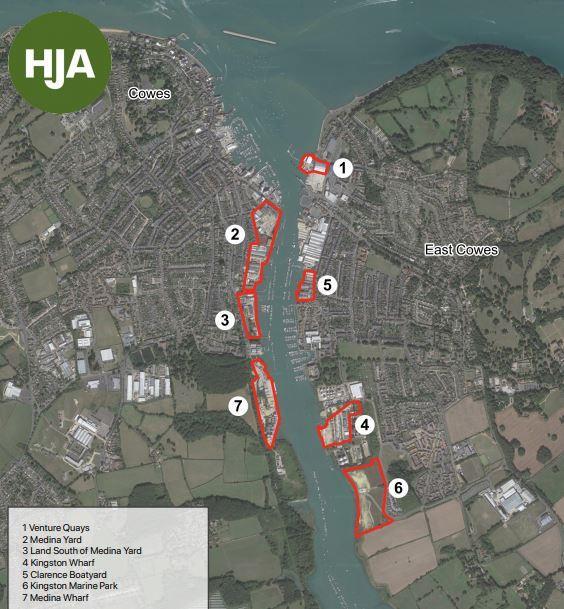
• The business parks form a very distinctive central band of connected and adjacent sites running along the boundary between the two parishes and thereby creating an area of common interest to both councils.

• Approximately 150 business premises occupy these sites, including large multiples such as Aldi and The Range; multinationals and FTSE leaders such as Ascensos and BAE Systems; a wide range of SMEs and start-ups, such as The WightTricks sport academy, and non-profits including The Storeroom furniture re-use charity and the Isle of Wight Natural History and Archaeological Society offices and archive.
• A notable feature of this ‘enterprise zone’ is the extent of public sector partnership and activity. The Isle of Wight Council, through its regeneration team, has significantly invested in the creation of the Rangefinder campus, the base for Ascensos, and this work continues with the ERDF funding for additional business premises on the site. The Isle of Wight Council owns the whole of the Somerton industrial estate and the adjacent park and ride facility.
• Industrial floorspace availability in Cowes and Northwood is greater than in Newport, Ryde or the Bay area, and when combined with East Cowes creates a north Medina supply which is more than the rest of the Island combined.
• Regional funding support from the South East England Development Agency until 2012, and latterly by the Solent LEP, has been, and remains an important factor in local regeneration work, from Project Cowes and Cowes Marine Cluster in 2004, to the Solent Gateways in 2014 and the troubled Floating Bridge replacement in 2018.
• It is important to realise that the majority of the businesses in the industrial park zone, and all of the larger ones, are in fact in Northwood (118 are recorded in the 2018 Northwood Business Survey) and that the contribution of the parish to the economy of the North Medina is very significant.
The UK government Freeports initiative, starting in 2021, is likely to have some effect on the economic opportunities presented to the business communities of Cowes and Northwood now that the Solent Freeport has been confirmed.
• The Government's objectives for Freeports are:

o establish Freeports as national hubs for global trade and investment across the UK,
o promote regeneration and job creation – the lead policy objective,
o create hotbeds for innovation.
• The Solent Freeport bid, prepared by the Solent LEP and approved in March 2021, will concentrate on Portsmouth and Southampton but will necessarily involve some consideration of the Medina estuary’s industry and transport operations.
• The combined efforts of Cowes Harbour Commission and Cowes Town Waterfront Trust are critical not only to the successful management of the waterfront estate, but to the economic health of the North Medina community as a whole. The successful balancing of leisure use, essential transport, public amenity, commercial eventing, and the management and maintenance of the diverse physical infrastructure on which all of these depend, together represent a significant challenge. The urgent need for a coherent ‘roadmap’ that integrates these demands with the policy development of the Island Plan and the Solent Industrial Strategy (including its freeport), has been clearly, and repeatedly, articulated by stakeholder organizations and in commissioned reports most recently the Isle of Wight Council’s Island Investment Plan (December 2020).
• The local business community is represented and supported by an active business association, covering Cowes, Northwood, East Cowes and Gurnard. The CBA is, at the time of writing, reviewing the services it offers and looking to extend and enhance its local and district impact. The association is particularly keen to welcome non-profit, charitable and civic organizations to join its membership, aiming to build a wider base of economic and social enterprise activity.
• 300 scored place standards
• 500 individual respondents

The baseline numbers for the Place Plan consultation
• 2700 separate written comments and suggestions
• 7 stakeholder group meetings (online)
• 2 community consultation events (Northwood Park)
• 30 local plans and strategies consulted
• The Place Standard is a methodology devised by the Scottish Government and provides a simple framework to structure conversations about place. It considers the physical elements of a place (for example its buildings, spaces, and transport links) as well as its social aspects (for example whether people feel they have a say in decision making).The tool provides prompts for discussion and helps to pinpoints both positive assets and areas for improvement.
• An online questionnaire was used to gather comments, opinions and experiences from local residents, visitors, workers and commuters, in Cowes and in Northwood.
• The collated scores from the 14 questions create a simple visual response to the quality of the place and these ‘radar charts’ are shown first, followed by a representative selection from the text commentary also gathered through the online questionnaire.

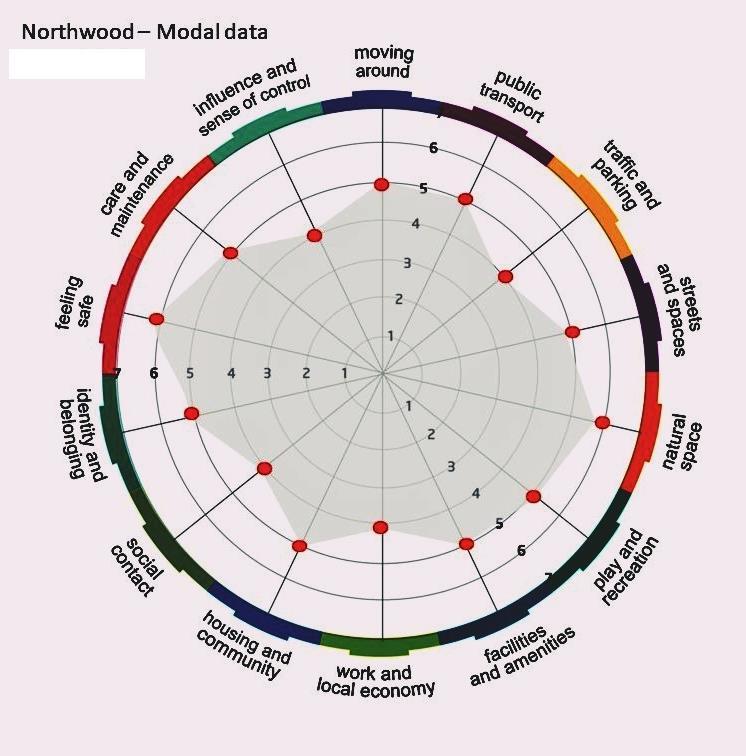

The radar charts usefully indicate underlying structural issues affecting life in the Place Plan areas:
• Both Northwood and Cowes are markedly uniform in their results, lacking significant dips or peaks and scoring at or above the average. This indicates a broad level of satisfaction with living and working in the project area. This is supported by the supplementary commentary online and by comments received at the live Northwood House events. A similar response can be seen in the 2009 IW Town Centre Health Check (Halcrow) for Cowes, suggesting a wellestablished foundation for overall contentment.

• Both Northwood and Cowes show dipped scores for Traffic and Parking and again this is emphasised and further explained in the survey comments provided. These issues are common to all of the public consultation results undertaken by the Isle of Wight Council through the ‘Wight We Want’ survey, covering the proposed regeneration districts including West Medina that incorporates the Place Plan area. The negative responses for this category in Cowes and Northwood however stand out strongly against a generally positive background. The very high population density of Cowes as a parish, and the dominance of road infrastructure in the everyday life of Northwood are likely to be causal factors.
• There are small but important differences in the chart data for the two communities. Northwood scores lower for Social Contact than Cowes, and Cowes scores lower for Housing and Community. Population density factors are likely to play a part here too, but these results also highlight the isolation problems faced by some parts of the Northwood community, and the stress on available and affordable housing in Cowes compared to the increasing residential development in Northwood.

It is extremely difficult to cycle round Cowes when the most desirable route through town is prohibited to cyclists - all alternative routes involve a lot of going up and down very steep hills, narrow roads and cars travelling too fast.
Car remains king in Cowes. Bizarre that cars can drive at permitted times along the pedestrianised High St but bikes can't! Cycle links between the town and the Cowes - Newport track are incoherent
Change bus route to use circular route by M & S (exclude Fountain Sq)
I love the pedestrianised High Street in Cowes, although it is annoying when delivery lorries drive in and pull up in the mornings.
The cycle path should have better onward travel into Cowes -it just spits you out and then the rest of the route into Cowes is difficult to follow and unattractive.
Arctic Road is a problem for both end cars routinely park on the pavements causing an obstruction for pedestrians.
No priority given to walkers and cyclists. No rest spots on railway/cycle path for walkers.
Please note that many of us in the High street are getting thoroughly fed up with all the cyclists who do not dismount at the beginning of the pedestrian zone in the high street - they go far too fast and it is a risk for those of us walking along the high street.
Places like the new car showroom, Aldi and the Range mean you have over-sized hotspots of plain-ness and the walkway near Aldi - along a stream is always full of supermarket litter.
Additional footpaths (not road-based) between Cowes and Gurnard or Cowes and Northwood would be useful.
Walkways and cycle paths along Baring Road , crossfield Avenue towards the main schools - perhaps Mill Hill too towards Lane’s End school would be amazing.
The bus services for Cowes are frequent but they are so expensive that it is cheaper to take a car and park especially if there are more than two of you.
If bikes were allowed on buses, that would potentially increase my interest in using public transport, as it would allow me to cycle somewhere and take the bus back when it's dark, or go on a 'one way' cycle and take the bus back.
It would be great to have some electric bicycles to hire at the Red Jet terminal…
The sorting of the ongoing floating bridge issues are vital to keep links between East and West Cowes.
Ferry services are expensive. Improve bus service along sea front.
The lack of bus provision for school children at Gurnard and CEC schools leads to a great deal of extra private car journeys.
.. more bus stops should have bus shelters with perching seats.
It's really good from the centre to Newport but gets a bit ropey as you head out toward Gurnard.
That the buses continue to try and snake through the archway entrance into the Red Jet drop-off area is madness!
The public transport is very expensive meaning it is cheaper for my household to run a car. I would prefer to use public transport if I could.
Bus routes into Cowes needs to be expanded (prevent bus accessing Red Jet, more direct routes to West Wight)
Outskirts of Northwood, Gurnard and Cowes could do with a more regular service.
Floating bridge!!
On the whole traffic and parking in Cowes is good, there are clearly signed and well used visitor car parks and park and ride facilities.
roadside parking is overcrowded causing people to park dangerously on corners and pavements. Need to have more parking areas available for residents only.
Traffic congestion and inconsiderate parking at school drop off and pick up at Gurnard School causes dangerous situations.
More 2 hour free parking slots for shoppers would help the town centre businesses.
Long stay parking in the town is inadequate. However, the park and ride system is excellent. Affordable parking poor. discourages me from shopping in the town centre and a hassle when catching red jet.
..there is lack of traffic calming, speed signs and safe crossings.
Changing traffic priorities - buses terminating at M&S.
There is too much parking on the Parade. This could be lovely situation for outdoor café / dining / performance / farmers' market if it was made either car free or with much less parking. Ok out of season. I think more could be done to inform visitors as to the park and ride alternatives to driving into the town.
School run parking on Baring Road , which is often done in a hurry , leaves little space for children cycling in the cycle lane, due to cars parking on the ends of it or people driving in it.
For some people it is sufficient but for people with mobility problems it is poor. It is also very expensive and should be free after 6pm.
Not enough parking for cowes residents
…repurpose St Mary’s road car park into a better community use, as car park it is unattractive and a bit of a blight in the centre of town. This site could be redeveloped into a community square (Mediterranean style?) with public space, cafes and restaurants and green assets for the enjoyment of all…
There is a fair amount of parking available in Cowes, with 4 car parks close to the High Street and some short stay on-street parking.
Parking along the sea front should remain free
Parking in back streets chaotic
The seafront is being spoilt by allowing Victorian villas to be knocked down and unattractive flats to be built in conservation areas on the seafront.
I think we are terribly lucky in Cowes to have people who take pride in our area.
What happened to fitness equipment on some open spaces in Cowes?
Cowes lacks a good independent fruit and veg shop.
I think Cowes High street/yacht haven/marina could do with one or more good waterfront cafe and public seating areas to encourage people to linger and enjoy the view.
Both Gurnard and Cowes are very pleasant areas to visit with attractive buildings and some lovely shops.
Create more interesting social spaces in town
Create priority route from one side of Cowes to the other for bicycling
I preferred Mill Hill Road before they chopped down all the trees. It used to be very green. I think we need more green where ever we can.
The entrance to West Cowes from the Redjet terminal is poor
More arts and cultural spaces.
All looks lovely, plants, green spaces etc. well looked after.
The Parade is good but the High Street and town streets are very difficult to get around. The Parade could be improved as a social space and made much more attractive.
We have Northwood House and Park, Northwood Recreation ground and the Green, by the sea, which all contribute to making Cowes a nice place to live and visit.
The combination of seaside walks, northwood park and the cycle track to newport make it very easy to enjoy natural space for those that are mobile.
Start with the public realm... working with all stakeholders to really make sure our streets and public places, spaces, access to the sea and to the parks, rivers etc are working to the best of their ability for people as well as wildlife.
Really work that Biosphere button! Make the most of that built and natural heritage in Cowes and bring the community, business, family, housing association, town/gown together.
We're home to stag beetles, swifts, sparrows and starlings, rare wildflowers and all sortsevery day common things that are actually at risk. We do have some fantastic places but it would be brilliant to really see them uplifted
Stop urban creep joining Cowes, Gurnard and Northwood.
Northwood park is lovely. The trust should be congratulated on its performance.
The use of the word ‘private’ is prolific! Private beach, private road, private entrance...
There are plenty of spaces with excellent potentialNorthwood Park, Moorgreen Rd Reservoir, Princes Green & beach, Mornington Rd woods. The visibility / access to these areas is not great and the aggressive management regimes sometimes do not seem to encourage nature or people!
There is virtually no access or views of the waterfront from the High Street, its all 'private' space - Ditto the River - it might as well not exist - There are few green ways in the centre of Cowes - i have to walk about 20 minutes to reach anything partly rural…
…a lot of the town, particularly near the Medina has no access to green space, unless you include the Cemetery.
More trees, green places and parks to walk dogs and socialise would be wonderful.
We need more conservation planting. More trees.
More greenery in the streets would be great, alongside more creative use of existing green space - like the scrap of grass at the top of Smithards Lane, or the green areas around Fraser Close.
Preserve our green spaces from a proliferation of new housing
I think park facilities are excellent and all are free to use. The play parks at Gurnard green and Northwood Park as well as the skate park at the cricket ground area are well maintained and accessible to all.
Children's playgrounds are well laid out and safe for children to use. A welcome attraction is the outside gym areas which are being used by young and old alike.
Indoor or covered play area
A swimming pool in Cowes would be great and surely shld have been in the mix for the new CEC buildings. Play equipment at Northwood Park is poorly located and shld be relocated. Near the new destination cafe perhaps?! Play equipment is generally good at the Rec.
There is nothing that is a small child’s walking distance from my post code.
The new 3G pitch at CEC is great and a real asset. More use cld perhaps be made of CEC's sport hall to the north of the 3G pitch?
Activities for older residents seem to be more limited to bowls
Lovely spaces, but more for older children are needed.
There are lots of areas for play and recreation. Northwood Park, Recreation Ground, Playgrounds. There is perhaps a lack of space and facilities for older children. Where have all the Youth Clubs gone?
Improved seafront facilities
- resurfacing of the paved areas; refurbished railings along the sea wall; children's play area at Mornington Green for families with younger children to stop and allow the children to play.
If we could open up school facilities ....we have great opportunities for sport. Northwood house partnership doing a great job We love Princes Green and the walk to Gurnard.
Excellent library (wish it was open 6 days a week though).
Another GP surgery and NHS dentist would be good as can never get appts there, and unable to get on NHS dentist
Lack of cafes on the seafront. For me personally the lack of a cafe like the Quay or Caffe Isola where I would feel comfortable sitting and studying for an hour or so.
We still have our library - just about. The volunteers do an
Pretty much have everything you need in Cowes.
Cowes is a wonderful town. I hardly need to go elsewhere for my day to day needs.
Good selection of schools with good reputations and again, good range of shops to cover all requirements.
The Medical centre needs more doctors. We have lost the dental services from the centre which was a great pity.
I feel that the local amenities support the adult population but am not sure how good they are for young people.
Doctors surgery has always been a good facility, but it can be difficult to get appointments sometimes.
I love all the small businesses utilising IoW products and showcasing the talent on the island
Support for Cowes library as social hub
Public loos in Cowes are an embarrassment. Shops are wonderful. Love the mural in The Cut
job of keeping the place going; always re inventing themselves. there are numerous places to relax and join in, so many clubs, would take forever to write.
Too many charity shops, real estate agents, financial advisers taken up prime retail space.
Health and dental care for local residents should be improved as a priority
The town and Harbour needs to decide if Cowes is a tourist and leisure destination or an industrial port for the manufacture of commercial craft. At the moment it is failing against competition for both.
Promote local industry and don't allow areas such as the old White's boat yard become blocks of 2nd home flats for summer visitors
We have world leading maritime training facilities, marinas and boat building businesses. This is outstanding if you are in the maritime business but there is great deprivation with a high level of alcoholism
The town needs to attract more business start ups into the empty shop, creating job opportunities for many.
For a small town we are very well served with several large industries within walking/cycling distance and work in Southampton and further afield within easy commute. Also there seems to be a healthy influx of young and vibrant companies choosing to locate here.
The sailing industry of Cowes provides some local employment but I think more could be done to exploit this from the shore based perspective eg better liaison re accommodation/ entertainment / information between the sailing clubs and the local community.
Development of centres of excellence for renewable energy or marine biology would encourage alternative groups of people here.
As with the rest of the UK, Cowes is losing its ability to be self-sustaining in terms of services and local industry. Natural centres of expertise must be encouraged. The introduction of fast fibre web links is a good start to growing activity.
I'm not aware of provision for artists studios or a creatives space in the [town]despite their being a good number of artists etc living locally. Given the high number of vacant shops - especially seasonally - perhaps there are opportunities to use this for popup work / exhibition space.
There are very few options for work if you want to work in Cowes. Income is low with the majority of people offering minimum wage and work is not varied.
Jobs in Cowes are very limited. I travel to Southampton for work. For many people, this is not an option due to the ferry fares.
Thought should be given to how many second homes and holiday lets a place will be able to sustain. It would be sad if Cowes were to become like other areas of the island which has lost much in the way of community because so many properties are occupied part time.
New housing out of character
There is a variety of housing styles and prices in Cowes. It would be good to see some innovative community led housing such as cohousing groups to help foster as sense of belonging.
Some more starter homes would help the younger generations.
The Planning laws need to change to protect the views of the sea.
Cheaper, affordable, close to town centre homes seem to get used for the leisure and tourist industry as second homes, airbnb, crew houses etc which potentially make it harder for full time residents to buy or rent homes at a reasonable market value.
Too many new builds for those with considerable income. Nothing for the workers on minimum wages or just above. Rents too high. No social housing has been built in years.
The need for affordable housing and social housing for local people.
The planning office should take more notice of local plans and studies which have identified local needs.
Invest in good quality, design and build, social housing to help first time buyers and those who've just started working, get onthe housing ladder or at the very least, afford to rent good quality accommodation.
Rent is too expensive. Houses are run down and overpriced.
Our brightest young workers are leaving Cowes as they cannot afford the high cost of housing.
2 separate property markets, open and local, as in Channel Islands.
There is not enough social housing and we should not sell any.
Need to have more starter type homes for young people - most housing appears to be top end e.g new houses in Place Road and Baring Road.
I think there is a lot of room for improvement in this area. I am not encouraged to go and meet people in our town. There are places in Cowes for social interaction but this could be improved particularly for older residents.
The IW Community Club is a great facility for a wide range of ages and interests and is well used. A sports/leisure centre with swimming pool would be a great asset to the town and its visitors.
There needs to be a huge improvement in youth services. Places for youth centres needs to be introduced.
I am happy with my opportunities to meet people but know that older relatives would welcome more chances to socialise.
I've never seen a busier or better used library, there are a ready supply of church halls and other locations which I know get used for various gatherings (yoga, sea-scouts etc) though I'm not sure if the elderly are that well served.
If you can afford yacht club membership, there are opportunities. Small communities like Gurnard do more, like the film society and various village groups. Good outdoor space. Poor indoor
There are lots of opportunities and on the spaces to meet people in Cowes if one wants to. The Cowes Community Club, Cricket Club, Library, Beckford Rd Centre; all have clubs and activities, as well as the churches. The housebound people are those most in need of support, and I think they must be the most lonely; I think Age Uk are a very great help for those who cannot go out.
lacking in communal spaces outside of the immediate town centre and waterfront
New Community Centre
Cowes does not have a centre.
Please develop one
Good for the sailing community. Not sure about everyone else?
Cowes certainly has its own identity as the national sailing centre, but the accent is just on the sailing. Most people in the town have nothing to do with sailing.
I love this place but I'm not really into sailing of any sort so I can never totally 'belong'.
Most feel a fondness for Cowes but is that enough?
Some areas are better than others for people to feel connected to the community; each ward has a different set up. cowes medina totally different form cowes west area.
Great place to live and work, very proud of Cowes
Cowes has a strong sailing identity which revolves around wealth. I do not feel that I belong here.
I think Cowes does have a positive identity, and I find it is a very friendly place to live.
The shipbuilding industry on which the town was built is probably not as well understood or visible a part of the heritage and could certainly be celebrated more.
I feel very loyal to Cowes but we need more integration between the Harbour and the town. The townspeople and town councillors need to realise the importance of sailing to bring visitors with money into the town. The Harbour Commission need to work with the town to promote this.
Anti social behaviour late at night during the summer, especially through Cowes week, could be better managed.
mostly but sometimes, feel threatened when revellers can be heard fighting and arguing on their way up the hill at night.
I think there are definitely areas I wouldn’t like to walk around on my own in evening but town is generally good.
I generally feel very safe in Cowes but there is a problem with drinkers especially late at night when the town can become quite a different place.
Feel totally safe. Good community and fabulous neighbours
Weekend nights can
be a bit lairy in town, outside of Cowes week there seems to be no police presence.
I feel safe in my town. There are always dark and narrow places that make you feel uneasy at night if you are walking on your own. Better lighting in these areas would help (for example along footpaths at Northwood Recreation Ground).
feel safe walking round most of Cowes most of the time
Public buildings and spaces, generally well cared-for. Private property often near-derelict.
I feel that most of Cowes is fairly well maintained. maybe some more recycling options would be positive.
Dog mess continues to be a problem in Cowes. Refuse bins from holiday homes can sometimes be left on pavements for days.
Public toilets need to be kept better, and the toilets in the park need to be reopened
Rebuild the outdated bandstand it is a focal point and lets down the town and is out of character for the town too.
Generally the town seems well cared for and tidy.
The area by the chain ferry in Medina Road needs to be renovatedthe old Whites building and units behind is very derelict and gives the town a very poor impression as it is one of the main gateways into the town
Less unnecessary signage.
The ordinary man or woman on the street is completely excluded.
No, I don’t think the council has a great record in engaging effectively with residents.
This is the first time I have felt able to express an opinion. I wouldn’t know how else to.
I think there needs to be better communication with local people with ways made clear of how to make their opinions known
Encourage young people to get involved in the community, listen to their ideas, needs and respect their experience. Use younger role models to help get people into community change projects.
You need some change in all these committees.
Everyone is friends with everyone so it makes it easier to push things through. It’s not diverse enough. Cowes is dying because of this Cowes power thing
I don't really feel able to take part in decision making and changing things for the better…. We need more integration between the Harbour Commission and the Town Council and more public consultation on important matters
Encourage the public to attend Council meeting and speak about issues which affect them.
To be honest I wouldn’t necessarily know where to access information...
I feel involved thanks to the good work of our local councillor
Lots of opportunity to comment, however not sure how much is listened to - especially with regard to the Harbour
more surveys like this Initially, a local think tank to identify priorities.
It is important to look at what decisions are made and have input rather than moaning at decisions you don’t like but which you could have influenced.
I have a voice, but the local authority never listen to the community
People feel that there are a few people who have strong opinions and generally they moan about everything so therefore people don’t bother.
There are no democratic arrangements for the public to take an active role in decision making.
Cowes Town Council active in community, eg this survey, Place Plan Big Lunch and other events
Communication with the public is almost nonexistent
I have never attended a town council meeting and am not sure how this works, or whether I could have any real input into decisions made for the town.
I have found town and county councillors responsive and helpful
I do feel it is a little bit too focused on bringing in people with lots of money and poorer parts suffer or pushed out

Lack of pavements on key roads, coupled with high traffic at certain times makes walking hazardous. This is especially apparent at the top of Pallance Road where there is no pavement on The Range side of the road.
I would not allow any child to cycle to school anymore as it is just not safe.
Have an extension of the pavement from Four Cross to the Range on the west side of Place Road, which would make it safer for residents to walk down this road from Northwood
We usually have to walk along these roads to access safe footpaths. All routes need measures to slow traffic down and improve lighting at night.
Access to and from cycle track needs extending up to business parks
Northwood is divided by two busy main roads, which means cycling is not suitable for all. However, the cycle path that runs from Cowes to Newport is excellent, the problem is getting to it safely. Maybe a shared pedestrian/cycle way along Nodes or/and Newport road?
In the 'Northwood - Welcome to the Parish' booklet (c 2009?) there are some excellent walking routes worked out - it'd be good to update these and to waymark them clearly and at the same time seek to address road sections that are unsafe and to highlight open spaces where children could play or places for people to gather or sit.
The narrowness of the roads also results in wing mirrors of buses and lorries coming extremely close to a person walking along.
Footpaths in general not lit and I would not use any of them after dark.
Add pathways or cycle space along the main roads.
A coherent road and traffic plan that encourages people to use the roads for walking and cycling, to school and for leisure; one that views Northwood and the approaches to Northwood as a residential area with strict speed limits eg '20 is plenty' Clear strategy for road safety in the local area based on residents perceptions including greater use of cycle lanes and safe places to walk. This should be in association with a clear health plan that actively addresses the poor health and physical fitness within our local community.
Establishing a stronger sense of community. Better cycle/walking access to the town when not travelling along the Newport Cowes cycle path.
The Community bus service that runs around the back roads is one of the best, although it only does mornings 6 days a week, so, there is room for improvement as it is a well-used service. Also, public transport is quite expensive on the Island.
Service along Pallance Road is limited to the No 42 and the walk to the bus stop in Nodes Road is too far for many.
Frequent but expensive
Cost of bus transport is expensive - cheaper to go by car!
I would use the bus if it were easy to get to the nearest bus stop but with fast heavy traffic on newport road and no pavement on our side of the road, i don’t feel safe. I use the bus infrequently and find it very expensive. Subsidised public transport would reduce traffic and help make our Island a safer, greener place
Red jet and ferries too expensive and need to run with greater frequency. Nothing more annoying than missing your ferry knowing you cannot get another one for 1 1/2 hours. Floating bridge is unreliable.
I live on a well served public transport route. Sort out floating bridge which is too unreliable to use for travel to work to get traffic off the Newport Road.
The main bus route through the top of Northwood is very well serviced.
Desperate need for SPEED reduction and TRAFFIC reduction in Pallance Road. Pinch point at bottom end of Pallance Road adjacent to Pallance Lane would slow traffic. Traffic entering Pallance Road from Pallance Lane would be less vulnerable. Pedestrians would feel safer and the residents would be very grateful if the slower traffic would reduce the noise level.
Traffic calming, enrich spaces and make the Island more ‘Green’. All will boost the economy and tourism
Not much parking in Northwood. Park and ride is a great scheme though.
[Increased traffic cutting through from West Wight is] not only very unsafe but lethal; most [roads] have no pavement or road markings to delimit walking or cycling area.
I am concerned that the rapid home building in the Cowes area will increase the traffic further. As a result health and well being of Northwood residents will suffer due to increased pollution etc.
There aren't enough traffic calming measures in place along Pallance Road and cars parked roadside at the bottom of the road (and top) cause a hazard for walkers, cyclists and other road users. Pallance Road is often a 'rat run' when there is slow moving traffic along the main Cowes to Newport Road yet it is not suitable for this purpose.
I would like to see an increase in traffic calming measuresparking in certain locations where I live reduces visibility and cars often speed to get through gaps etc
Parking is always going to be a problem as more households have more cars. WyattsLane Oxford Street and Pallance road are becoming problems. People park both sides of these roads making it difficult to drive through and impossible for a fire engine or ambulance to pass, they need educating.
Less traffic, more affordable transport, more infrastructure and job opportunities
Pinch point/sleeping policeman at bottom end of Pallance Road
Northwood has green open spaces such as the park at Venner Avenue. But that is really it, it would be lovely to have some more outdoor spaces.
…it doesn’t benefit from the traditional village atmosphere of a green with pub, church and hall in close proximity. This I think, does affect the community feel of the village. It sometimes feels more like a suburb
I feel Northwood lacks an open public space for meeting with seating. Especially as we have a lot of elderly residents in the community. Somewhere that people could meet and sit for a chat with a few flowerbeds.
I feel some of the previous planning allowances have lead to a very disjointed looking area with no particular character
I believe the local parish council, plus volunteers, should be congratulated for trying to make the area as attractive as possible.
I am particularly thinking of the field off Wyatts Lane opposite the scout hut, and through the footpath. A lot of people walk their dogs through here, but it could be so much more. Picnic benches, small trees,shrubs and plants could transform this field.
From Northwood the ability to access to the coast by walking, cycling or driving is very easy. The Parkhurst forest and other open spaces are also within walking distance. There is also the cycle track with ability to cycle from Cowes to Sandown or Ryde or Shanklin.
There is very little natural space in Northwood itself, however there is plenty within relative easy access such as Cowes seafront, park, recreation ground, river and Parkhurst forest. We love the park in Northwood estate and easily accessible walks to the cycle track through Medham.
I generally have to drive to access green space as Newport road is often too busy to cross easily
No parks, very few footpaths through fields or woods.
There is a lovely park
The play park is very good for small children and footballers but no real meeting places for teenagers
like I've said with goals and football area. It would be lovely to have one of the outdoor gyms as well. Also some play equipment for toddlers
Northwood only has one park, it could do with more outdoor recreation facilities for children and adults.
The area is lacking easily accessible play and recreation facilities for young people, although Northwood Recreation Ground is not far away.
I feel there is a lack of facilities for all ages in and around Pallance Road.
Northwood has a play area for smaller children and other facilities in the form of a village hall and scout hut for other ages. Open spaces are within easy reach by foot, cycle or car.
Purchase of unused BAE fields.
There are a few aspects that are unsatisfactory. GP facilities are good, IF you can get an appointment, prior to Covid-19 getting to see your own GP was virtually impossible!
Northwood entirely served by Cowes, they have no facilities of their own.
The doctors are becoming over whelmed by the increasing population in the Cowes/Northwood/Gurnard area
I am completely happy with the facilities and amenities in the area
GP surgery and dental
practice has become poor in recent years.
Nowhere in Northwood, you have to travel to Cowes or Newport
The few shops and public houses fulfil a need, and it is not surprising that residents have to venture further afield for other facilities.
There are no cafes in Northwood at all. This is something that is lacking. I know many people have mentioned this. A little tea shop and bakery would be a lovely addition to the village.
With there being no clear village centre, most services I need to access are in Cowes or Newport. I use Gurnard village for shopping and community services.
Almost all my needs require a car journey, made worse by the very limited opening hours of the local Post Office and the uncertainty of its future.
Thank fully we have a small shop in Northwood. Anything else means a drive to Cowes or further Great schools
. The doctors surgery isn't far so that's not so much an issue. However there are no NHS dentists in Northwood or Cowes so I'm having to go to Bembridge. This could be improved on a lot.
No dentist
We need more availability to doctors and dentists.
Not in Northwood and it would be nice to have more work opportunities in the village.
Northwood has more than its fair share of businesses and two popular pubs. There is nothing pulling all these resources together though.
Have a sign board at the entrance to the Business park identifying which businesses can be found there.
The local economy offers few job opportunities, although Cowes and Newport are easily accessible.
There are some great schools in the area but we are limited here on the island as most jobs are seasonal and low paid. There is much room for improvement regarding worthwhile training and apprenticeships.
As Northwood is a village there is not much scope for an economy here but that said, Aldi have created many jobs, and we have the garages.
Northwood tends to be a residential area, most people work elsewhere.
Housing and Community
I believe some starter homes for young couples would be much appreciated; too often new developments in and around Northwood comprise homes aimed at the upper middle classes, beyond the reach of so many Island families.
. I think Northwood has got the housing issue just right. No more new builds thank you!
I think the area has a fairly balanced housing stock.
Insufficient housing for those with low income, rents have become extremely high which puts strain on households as well as the council who have to make up shortfall with housing benefits.
There is a lack of accommodation for young people. The housing that Planning wants to try to force on us is not what the local community wants or needs.
Lack of 2/3 bedroom affordable housing
There are too many houses being planned for this area
. My concern is that more and more of our younger people leave the IW in search of jobs and affordable homes leading to an ageing population.
Any new houses need to be 'affordable'. Housing needs to be finished and occupied before any new projects. Green fields space should be preserved
I think Northwood is limited in its ability to offer social contact. The W.I. Hall is a useful asset, but is too expensive to hire and away from the centre of the community for a lot of residents who may have mobility problems. Something like a cafe or social club is required in the centre of the village.
The Village hall but that is not open unless you belong to certain groups
I have never felt a sense of social contact in the area
Only if travel out of Northwood
There are various groups that meet within Northwood, mostly for the older and younger members of the community. Other age groups tend to be more mobile and use facilities in nearby areas (Cowes, Newport etc).
There is no place that draws people together in the centre of the area. Maybe this would be a good development. However, there are good networks around the pubs, allotments and scout hut in addition to the school. The church is a wonderful place to be but is out on a limb!
Open space but nowhere to sit and meet
Building a purpose built Community Centre, near say, Venner Avenue.
Quality, attractive outdoor meeting space for all, not just children. Somewhere to sit and have a coffee or snack.
Northwood is a bit lacking in this area but providing you have a car there are opportunities.
Northwood doesn’t really offer many social spaces, we have a scout hut for the youngsters which is great and a WI Village Hall which does offer some social events, but a coffee shop type affair like Gurnard Press would make a lovely addition to the village and could become the main hub of village life.
It would be nice to be more sociable without having to join a church or society with membership. Schools don't promote a sense of community despite having spaces to offer for this purpose.
Set up community groups
Northwood feels like a place full of retired people,
I've lived in Northwood for many years, and I know many people through working in the school. But as there is a lack of a central hub/coffee shop/meeting place I feel this needs improving. There is a WI hall, but it's very dated and could do with a complete makeover, and better parking facilities.
…as a fairly new member of the community it is difficult to fit in and find places to socialise without joining groups with paid membership eg slimming groups, fitness groups
Northwood has a fascinating history but not well known and seen as just a suburb of Cowes
I absolutely love Northwood. It is a very quiet, peaceful place to live.
The school community provides this for me.
I think Northwood is perceived as a good place to live by many but lacks anything that promotes a local sense of identity. The constant treat of large developments is very damaging to the community.
As I have lived here most of my life I feel I belong.
Northwood is quiet but holds a strong identity. I am sure that many people just pass through it, not knowing it existsthinking it is the outskirts of Cowes or Gurnard
I do feel I belong to Northwood, although it comprises two very distinct areas - the small collection of homes around Northwood church and the rest of the village some distance away.
Petty theft and burglaries seem to be the typical crimes in the area. Generally I feel very safe in the area. Some street lighting is ineffectual as the lamp posts are either too short or spaced to widely.
The only unsafe aspect for me personally is that of traffic.
I do feel very safe in Northwood as there's not a lot of crime. If I was completing this for Cowes my answer would not be the same. Nice environment with perception of a low level of crime.
Pallance Road lacks good street lighting. There are some very dark areas in the road. Households who install their own security lights are supporting their neighbours but more need installing. As in my previous notes, the road is definitely not safe. There were two bad accidents in the last year. On one occasion, two stationery cars were written off and on another occasion a stationery car had its drivers’ door ripped off.
I believe that Northwood is well tended generally, however, I am confused about the status of Roger Mazillus' "Village Green" as that never seems to receive any attention, resulting in it not contributing what it might to the village and preventing it's full potential from being realised.
Yes I think on a whole Northwood is well looked after and residents take a certain pride in keeping it nice. Picking up litter, cutting back hedges etc.
WI hall outdated No outdoor meeting space for the elderly Scout hall could be opened up to the community more.
Not enough recycling areas.
Yes the village is very well looked after. The only thing that is not very good is the amount of dog poo on the pavements. It's seemed to have got worse.
I think the vast majority of Northwood residents take pride in their homes and gardens, and value the work done to maintain small public green spaces together with their flower boxes.
A free news leaflet and village website keeps residents informed of matters concerning Northwood and offer opportunities to offer opinions or to take part in decisions.
I have the impression (rightly or wrongly) that I would not be able to influence IOW Council in any decisions that affect the area and I'm unclear how I would register a concern with the Parish Council either.
Better coordination of resources Better realisation of local assets and amenities
Better channelling of views, interests and opinions of local residents, businesses and visitors
I could be able to take part in decisions to change Northwood to become a more enjoyable village for its residents. This is even more important now through the ongoing crisis.
I don’t feel residents views are taken into account with regards to new house of projects
I wouldn’t know how to be a part of this
Yes people are free to join in
Parish council has very little influence despite its best efforts over Isle of Wight Council which ignores local opinion on issues such as planning
Aside from this survey, I have never seen an opportunity to give my thoughts on such matters so no, I do not feel able to influence any change
• There is a substantial directory of data, survey, study consultation and assessment covering the past twenty years for Cowes and its surrounding areas including Northwood. In addition, there is the mapped policy framework for land use and development that applies to both Cowes and Northwood in the Core Strategy of the Isle of Wight Council (2012) and its successor, the draft Island Plan. The Local Development Scheme for the latter sets out a timetable to adoption in 2024 with new public consultations taking place in the summer of 2021.

• The Solent LEP Industrial Strategy will be especially important and relevant to the North Medina community and is likely to resume progress in 2021 after delays over the past 12 months. This work will set out proposals and ambitions to 2050, incorporating the 2030 UN Sustainable Development Goals.
• The Solent LEP has also set out its case for Freeport status as part of a government bidding process begun in November 2020 and this was approved in March 2021. The Solent bid concentrates on Portsmouth and Southampton but there are likely to be significant opportunities relevant to the Medina and Cowes Harbour.
• These strategic regional and local plans and programmes can now be set alongside the Place Plan consultation, the public and stakeholder comment and opinion, and the more general conversation with local representatives undertaken during 2020 and 2021 under the strictures of Covid.
• The complete data set from the Place Plan questionnaire responses is also available as a resource to help with planning and prioritizing local projects and programmes.
From this total combined data set, three dominant Place Plan themes emerge:

• The need for a louder voice, not just for Cowes and Northwood but for the entire North Medina district that shares riverside access to the Medina and its estuary. There is a feeling that the big issues that affect the Place Plan area require greater local political, cultural and financial leverage, tackling systemic infrastructure weaknesses and their impacts on what are essentially peninsular communities at risk of isolation. The floating bridge, a future Medina crossing, an economically sustainable harbour, capacity in primary health care and in the provision of educational activity, all fall into this ‘cross-border’ category.
• The unrealized capacity for a strongly resilient and self-sufficient socio-economic foundation in Cowes and Northwood, using the existing pervasive network of civic, social purpose and non-profit organizations to reduce reliance on journeys out of the area for everyday living and working needs and building local capacity to support jobs, health, environment and opportunity.
• The need to move from a narrow debate about transport to a more useful one about local transit and physical networking, the safe, efficient and effective movement of people, goods and services between centres of community significance, especially important and productive in the densely urban environment of Cowes and the similarly compact, but severed, community of Northwood. The human need for free and easily accessible outdoor spaces has been brought very clearly into focus by the Covid pandemic and its constraints; work on enhancing and making more legible the local network of such spaces has an important part to play in the recovery of community wellbeing.
• The pattern of development, socio-economic structure, industrial focus and transport infrastructure is reflected across the Medina estuary creating a block of common interests rather than an east-west division.
• Cowes-East Cowes, Northwood-Whippingham, BAE-GKN, CECAMMRangefinder/Innovation Wight; Medina Wharf – Kingstone Marine Park, and more, clearly connect the four estuary parishes.
• The same fundamentally peninsular pressures affect all four, especially vulnerability to transport disruption and disconnect.
• The health of the harbour and the working environment of the estuary relies on the whole river mouth, its entire waterfront estate, and the interaction of these spaces with the communities that surround and host them.
• A single, coherent and compelling lobbying voice, a North Medina Forum, is required to respond to critical local infrastructure issues, such as the floating bridge replacement, as well as important regional opportunities within the Solent. The lack of rapid response, reliable and sustained support to the area when such issues arise is in part the consequence of a fragmented local voice and a policy-based division of the North Medina along the centre of the river.
• Feedback from stakeholders, residents, visitors and commuters alike suggests a frustration with both the assumed and real need to use Newport as ‘life support’ to Cowes and Northwood. This is especially so when combined with the persistent traffic congestion which has at times become severely debilitating (when combined with roadworks and floating bridge disruption).
• Yet the Place Plan area is characterised by a dense network of civic organizations, public and community service organizations, medical support, leisure spaces, employment and business zones, a functioning High Street and several supermarkets. The compact nature of Cowes urban space in particular means that nowhere is very far from these centres; this is less so for Northwood given its main road barriers.
• There is undoubtedly significant unused capacity within this network, especially amongst its social-purpose organizations (which dominate the municipal landscape) to collaborate, share activity and develop a strongly resilient and self-sufficient local community service structure, mixing public, private and third sector roles to the benefit of all. This is the basis for a proposed Resilience Group (a collegiate alliance of civic organizations) and a Sharing Economy model for the Place Plan area (and the wider North Medina Bloc).
• Feedback and comments from stakeholders and other contributors to the Place Plan are clear on the problems of permeability – the lack of safe and easy access between local places and spaces of community importance for as many people as possible.
• These issues are based on three factors:
o Worrying and dangerous roadside walking, exacerbated by the dominance of, and priority given to, vehicles over people in some areas (most significantly Northwood), lack of pavements in some places and too few safe crossing points.
o Poor waymarking, orientation and permeability for pedestrians and cyclists, impeding navigation through Cowes town centre and surrounding areas and leaving some places and features that could be explicitly connected, isolated instead ( for example open greenspace and the waterfront estate).
o The need to group or cluster public amenities under common schemes of management and promotion so that it is as easy as possible to find and use community services and facilities (for example the four community greens in Northwood).
• A way to deliver a combined approach to resolving these issues and to support active travel routes and destinations is through the production of a Local Network Plan.
• Establish a cluster of local councils working together as a ‘bloc’, comprising a core group of parishes that share estuary waterfront: Cowes, East Cowes, Northwood and Whippingham. Gurnard is of course closely connected and, it is hoped, would opt to participate also.
• Cowes Town Council would initiate the project, setting out key objectives, drawn from the Place Plan but of common interest to the group as a whole. These include:
o Management of, and investment in the North Medina waterfront estate, its essential Island wharf facilities, public amenity and commercial value. The role of Cowes Harbour Commission is critical in this regard and the dialogue between it, Cowes Harbour Advisory Committee and Cowes Town Council is fundamental to future progress. One mechanism for improved control and positive progress is the creation of a Local Development Order as part of the Island Plan redrafting in 2021.
o Active and constructive partnership with the Solent LEP and the Isle of Wight Council, both of which are already investment partners, and in the case of the council, major landowners, in the North Medina, formalised through MOU or similar collaborative framework and linked to the management structure of the Solent Freeport.
o Lobby collectively for essential infrastructure support; the floating bridge replacement and the persistent congestion issues that blight these areas, including those generated by the ferry services, are priorities.

• A key part of the work of the Forum will be the generation of opportunities for enterprise and employment within its parishes, concentrating on its locally distinct skill base and industry focus.
• There are well-rehearsed strategies for a marine and composites cluster within the Medina Valley including work commissioned in 2020 by the Isle of Wight Council and this clearly remains an essential focus.
• Making a connection between such strategic economic plans and the idea of STEM training and apprenticeship, as well as a more widespread opportunity to encounter and experience science and technology as a local speciality, is less developed but ready to happen.
• The successful Noel Turner Science Festival hosted by Cowes Enterprise College captures the spirit of this local speciality. There is much to be gained in spreading this ‘science hub’ approach from Cowes, across the North Medina, connecting with the Centre of Excellence for Advanced Manufacturing and Marine (CECAMM), the Rangefinder Campus, making use of the increasingly important investment drivers around sustainability and environmental responsibility. These are already creating change within major local employers such as BAE and GKN. There is a growing opportunity for Cowes Town Council and Cowes Business Association to actively engage in a more managed approach to spin-offs, start-ups and supply chains within local incubator spaces (across the area’s industrial park belt) that already have significant public/private partnership in place.
• A focus on STEM, beginning with the local schools within the Place Plan area, and across the proposed Forum, will build shared opportunities and aspirations for local enterprise and employment. The education sector is already one the largest employers in the area and one of the largest budget holders for local procurement. Aligning education with local investment opportunities through closer collaboration and cooperation between schools, the business community, and with the local authority as regeneration lead, will boost community impact and support the hope for positive change in work and local economy expressed through the Place Plan consultation. Precisely because of the strong educational basis for the STEM identity, there is the potential to develop ‘edutainment’ opportunity within the commercial mix, adding visitor appeal to research and industry.
• A federal, North Medina green technology agenda, especially linked to the urgency of the United Nations Sustainable Development Goals 2030, all taking place within a UNESCO World Biosphere Reserve, has the power to generate significant interest within the Solent Region, aligning with organizations such as Greentech South, creating R&D partnership opportunities with Southampton and other Solent universities, and building important connections with the Solent LEP via the emerging Solent Industrial Strategy 2050. The development of a Medina ‘Greenport’ as partner to the Solent Freeport, for example, would help to positively position Cowes Harbour. The work of the IW Estuaries Partnership is an essential component in this work of redefinition.
• The North Medina Forum area contains approximately 160 Ha of estuarine habitat, intertidal and shallow subtidal sediments, creeks, saltmarshes, riverside woodland and the urban infrastructure of the developed coast that plays its own part in this ecosystem. The combination of new Freeport status for the Solent, together with its designation as a World Biosphere Reserve, creates an opportunity to actively develop (and fund) the role of the North Medina district as a centre of expertise in sustainable estuary management.
• There are close working links between the IW Estuaries Project (based at Cowes Harbour) and the Solent Forum, including the work of its Natural Environment Group and Building Biodiversity Hub. Saltmarsh restoration projects are underway in the Medina in collaboration with Solent Bird Aware and there is a catalogue of agreed development-related habitat mitigation work and s106 environmental enhancement yet to be delivered across the district. This presents a perfect platform from which to define the Medina Estuary and its four riverside communities as a zone aspiring to co-ordinated, high-level environmental gain, starting at the river and coastline and running inland into connected greenspace and urban habitats.
• A particularly important focus for an environmentally driven district will be carbon management. The combination of Medina ‘blue carbon’ work on seagrass and saltmarsh with terrestrial sequestration and storage through tree planting and local conservation projects can be brought together as one theme.
• The timing of the Place Plan fits well with the revised Local Development Scheme for the Island Plan which will go out for public consultation in the summer of 2021.
• This creates a window of opportunity within which to finally define a single vision for Cowes Harbour and the working environment of the Medina estuary. Comment from stakeholder organisations makes an urgent case for leadership in protecting and promoting the waterfront estate for the benefit of the communities that surround it, the Island as a whole and the wider economy of the Solent region. A Local Development Order, or similar strategic planning framework, would provide the necessary tools to shape and plan positive change, assisting and refining the delivery of the Island Investment Plan (December 2020).
• Cowes is the largest centre of population in the overall North Medina community of 21,000, and the home of Cowes Harbour Commission. By taking the lead and initiating this essential debate with the Isle of Wight Council, Cowes Town Council, working with the harbour authority, is in a position to bring together the whole estuary community, setting out policy and decision-making objectives that will prevent the loss of critical industrial capacity to speculative and piecemeal development and bringing together the cluster of public and private waterside sites under a coherent partnership agreement with clear routes to investment.
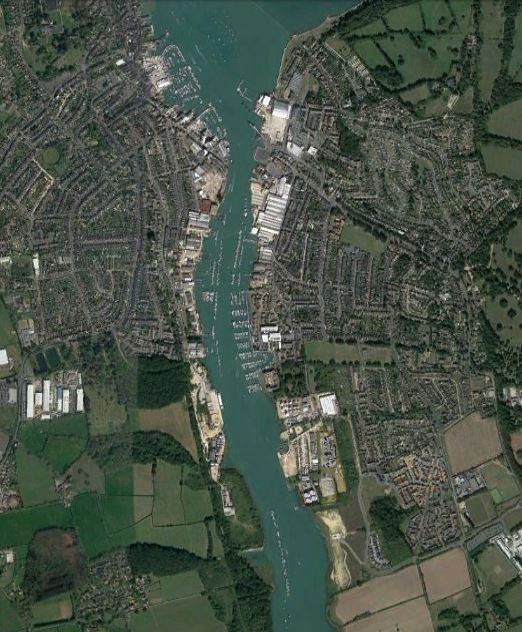
• The Resilience Group is a ‘civic college’ made up of representatives of the non-profit, public and voluntary sector bodies that dominate the organizational landscape of the Place Plan area, including: Cowes Town Council, Northwood Parish Council, Cowes Business Association, Cowes Harbour Commission, Cowes Town Waterfront Trust, Northwood House, Northwood Cemetery, Cowes Medical Centre, Cowes Foodbank, IW Community Club, Cowes Enterprise College, Lanesend Primary, Cowes Primary, Northwood Primary, Cowes Heritage and Community Group, Cowes and Northwood clergy, and the Isle of Wight Council (as service provider and local landowner).
• Its objective is to share information so that a collective (‘collegiate’) approach can grow between its members, facilitating and accelerating the development of collaborative working, sharing of resources, premises, projects and procurement. This will build a highly resilient and self-sufficient network of connected and well-informed social purpose organizations together delivering a mix core and ancillary health, cultural, educational, advisory, leisure and regeneration projects and services to its community. By creating an environment where civic organizations readily share information and operations, partnerships between them are made more likely. For example, the proposed merger between Cowes Harbour Commission and Cowes Town Waterfront Trust might be better supported in the future within the context of the wider collaborative endeavour which extends the benefits of their joint operations.
• The basis for this collegiate, collaborative approach already exists. Cowes Town Council provides regular funding support to some of the organizations involved and there is some sharing of knowledge through board level sharing of expert trustees.
• The Isle of Wight Council public asset register for 2019 shows 57 listings for Cowes, including surplus property and non-operational land. A positive precedent for local asset transfer has already been set by the success of the Northwood House restoration project, comprising land, property and revenue generation from car parking. There is therefore the basis for discussion within the civic group as to how other local public and community assets can be used to support local enterprise, regeneration and improved services.
• The transfer of off-street car parks to local organizations from the Isle of Wight Council to help sustain community action, has also been done elsewhere on the Island (with Ventnor Town Council, with Natural Enterprise/Gift to Nature). Given the public concern over parking provision in Cowes expressed through the Place Plan consultation, the combination of locally decided management and decision making, and fees directly recycled into community benefit that would come from asset transfer, this is a relevant and useful topic for discussion particularly given the comparatively small contribution that off-road parking in Cowes makes to the overall income of IWC.
• The concept of a sharing economy for Cowes, Northwood, and the North Medina bloc, is at the centre of a vision for a resilient and self-sufficient community. It opens up new ways to save costs and enhance service delivery, based on stable, safe, open communication between and within local businesses and organizations. One of the foremost expert organizations in this rapidly growing field is the Ellen MacArthur Trust which has its global HQ in Cowes. There is a unique opportunity to apply this international experience and expertise to the future of Cowes, Northwood, and the North Medina community.
• The same principles that underpin the sharing economy in the non-profit sector can and should be applied to the economic priorities of the Medina Valley - marine, composites, STEM training, tech industries, an approach in fact proposed by the SEEDA-funded Cowes Marine Cluster in 2004. A ‘marine campus’ with easy in/out terms on a project by project basis to suit SME development would fit this approach and find a home within the waterfront estate.
• The work of the Resilience Group can therefore be used to support a more sustainable approach to the way in which commercial and industrial assets are managed within the harbour and estuary and the North Medina district. Public investment significantly overlaps with the private sector across the Place Plan area and this provides a point of contact and leverage from which to develop more ambitious partnerships and collaborations.
CIRCULAR AND SHARING ECONOMY PRINCIPLES FROM THE ELLEN MACARTHUR FOUNDATION
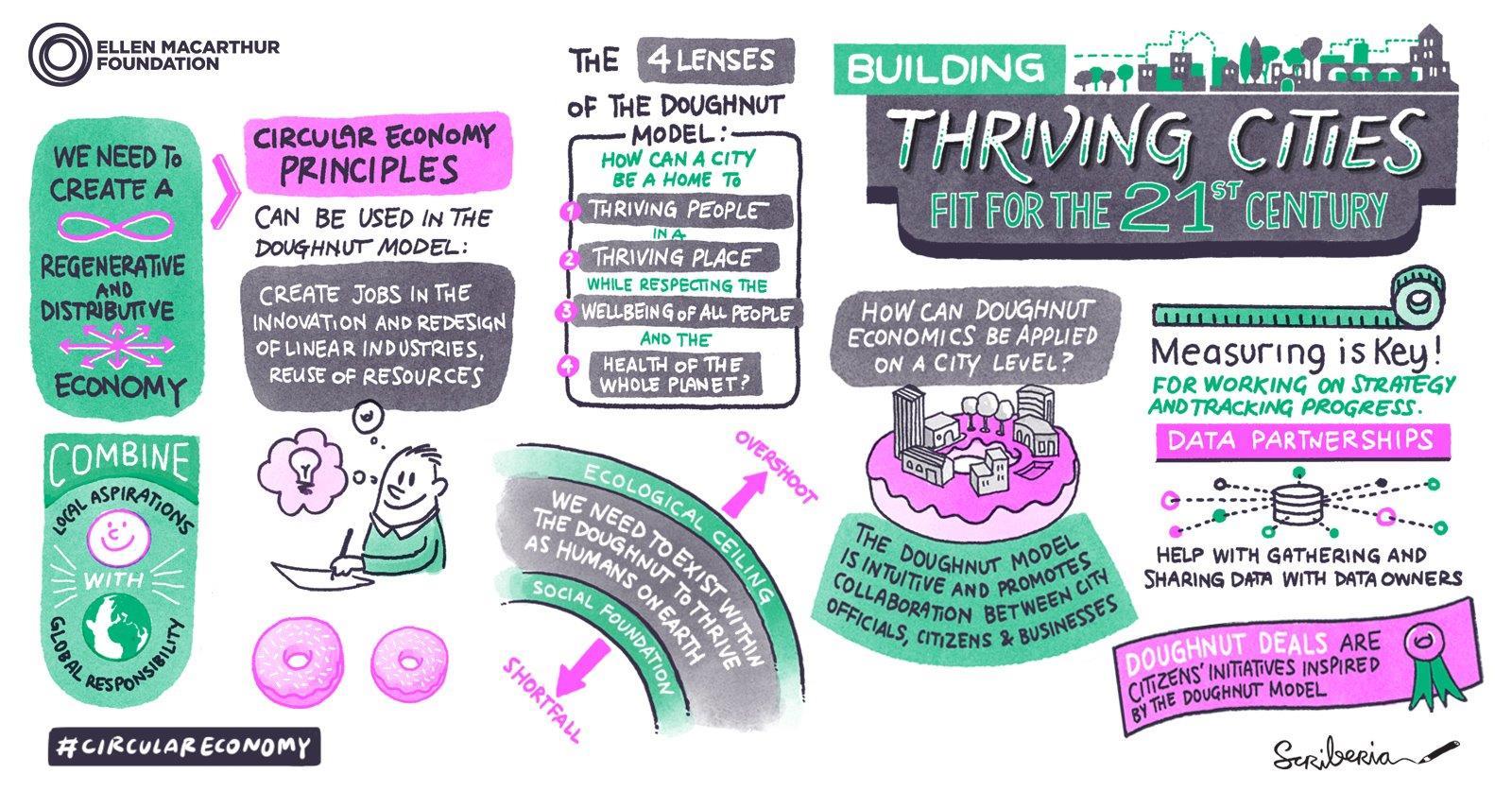
• Pressure on the medical centre is a significant community concern evident from the Place Plan consultation. By actively involving the centre and the CCG in a wider civic partnership, new opportunities for extended community services, ancillary support, local NHS provision and public health interventions can be created with the help of nearby venues and projects. This would include pop-up and peripatetic services.
• For example, the medical centre sits within the Central and West Health Alliance based in Cowes, Newport and Yarmouth. This primary care network has a designated social prescriber appointed to help direct people to a range of non-medical services such as social clubs, community support groups and exercise activities, that will help them take greater control of their own health and stay well. The opportunity to develop this to its full extent in Cowes and Northwood through the close network of civic organizations, social calendars and closely connected recreational spaces is very significant.
• By fully developing this approach, the potential for direct commissioning of local public health services, with the consequent injection of ‘wellbeing’ finance into the local economy, can be maximised.
• STEM has been identified as an important ingredient in the identity of Cowes and Northwood, both through the very strong technology presence in local industry and the annual Noel Turner Science Festival hosted by Cowes Enterprise College and managed by the Winchester Science Centre.
• This theme can be developed through the civic network, without altering or compromising the work and focus of the individual organizations, but helping to reinforce the importance of science and technology to employment, investment and regeneration in the North Medina.
• The STEM theme spread wider may support new funding opportunities for events such as the Literary Festival, Cowes Week and the County Show with support from the outreach programmes of organizations such as UK Research and Innovation.
• By developing the possibilities of STEM impact through the network of civic organizations, including the four schools, the opportunities for educational engagement with community and business will be expanded. This fits well with the learning and training objectives of the Solent LEP and Isle of Wight Council both of which are already funding and managing relevant local projects and programmes.
• The members of the Resilience Group together represent an annual spend of over £15M. Not all of this is spent locally and some is restricted by contracts and other fixed commitments. Nevertheless, this is a very significant economic engine operating within the Place Plan area. Changes in NHS commissioning that support the work of more independent ‘integrated localities’ on the Island will be an important part of a more localised procurement model. By better communicating work and objectives between members, the group as whole will find common areas where sharing resources can boost impact and reduce costs. A collective focus on local gains through procurement will be easier and more effective to manage and deliver through the collaborative framework created by the Resilience Group.
• A constructive relationship between the group and the local business community can open new opportunities for social enterprise, spin-off and start-up ventures from existing and future projects and programmes. ‘Impact’ investment may be attracted by the strong ESG (Environmental, Social, Governance) credentials of the Place Plan area, especially through the combination of new Freeport and Biosphere status.
• The work of Cowes Business Association is vital in bringing together these partners, especially the tenant and landlord communities of the High Street, and the ‘industrial belt’ enterprise zone that connects the two parishes. The aspirations of the CBA to engage with local third sector organizations fits very well with the idea of a locally mixed economy.
• The year of pandemic, its restrictions, disruptions and emergencies, has both exposed systemic weaknesses in public healthcare and released new community-based organization and action. There is an Island-wide need to protect, support and develop these street-level networks of assistance as a priority to build a more resilient future.
• More effective and sustainable working connection between the Island’s public health team, local NHS provision, CCG procurement and voluntary and civic sector organizations is key to a purposeful commitment to ‘build back better’.
• The Place Plan area councils, and the wider North Medina district, have been working with Community Action IW throughout the Covid crisis to provide emergency support to local services. Their work is now being developed into a model that will secure future gains for these communities as the political and economic agenda moves to recovery and renewal. The Resilience Group will provide the essential vehicle for this and other efforts to consolidate and sustain health-led neighbourhood working.
• The Resilience Group, its civic college framework and resource sharing principles, is the basis for not just rapid recovery after Covid, but for the establishment of a new and better way to shape a better place for those who live and work in its communities.
• The results of the Place Plan consultation indicate how significantly everyday life in Northwood is constrained and compromised by the dominance of road traffic and its associated impacts.
• The combined effects of the floating bridge disruption, St. Mary’s junction construction and more local roadworks have at times been crippling for local residents.
• These difficulties in entering and leaving the village are exacerbated by the significant internal problems of safely negotiating local streets on foot and by bike and the restrictions this imposes on residents reaching and using amenities and public spaces.
• The availability of safe local open spaces for all ages in Northwood is therefore a priority as is the creation and waymarking of safe routes that connect them.
• Northwood faces significant expansion through existing residential planning approvals underway and yet to commence, and through future development anticipated by the draft Island Plan. Both in their design and in their legal agreements, these schemes must contribute sufficiently to the mitigation and resolution of the problem of inadequate open space and unsafe pedestrian and cycle transit.
• The Venner Avenue recreation ground is much appreciated by local people and clearly provides a vital local resource for the village. Place Plan consultation responses suggest that it is too small a space to cover the wide range of leisure, recreation and health activity wanted and needed by the surrounding community.
• It is therefore helpful to consider the site alongside other public, or semipublic, open spaces in the village. There are 3 that are close and not separated by main roads: Northwood Primary School field, the Northwood Scouts field, and the putative village green. There are of course important restrictions that apply to both school and Scout land, but both nonetheless play an important role in the provision of safe local open space to a community in deficit of those resources. Both the school and the Scout site also have buildings that are used for community events.
• Northwood Parish Council is in a position to take the lead in building positive relations and agreement between the four sites and their owners and managers so that the best possible indoor and outdoor recreational opportunities for local people can be planned for and implemented year on year.
• An essential part of this work is to clarify the status of the area known as the village green. Recent approval for residential development has recognised the area as a community space but this must be formalised as a priority action.

• Northwood has outline permissions in place for over 100 new homes, approved in the past three years. Another 100 were included as allocations in the 2019 version of the draft Island Plan (to be published as a revised draft in summer 2021).
• It is essential that these developments promise and deliver sufficient new internal public open space for their own communities but also physically connect these, by safe convenient public access, to the life of the wider village. Included in this focus on safe access to recreational space must be the crossing of Newport Road to National Cycleway 23 and the necessary waymarked options and infrastructure for reaching it.
• A collaborative approach to planning is therefore required, delivered for example by MOU, between Northwood Parish Council, Isle of Wight Council and Island Roads to ensure,
o Good design at the application stage, delivering sufficient on-site open greenspace, play area with safe pedestrian and dual use connection to adjacent rights of way and public realm.
o S106 contributions to wider public open space to support the management of the local network.
o S106 highways contributions together with whatever other local investment from the PFI is possible, to plan and deliver critical improvement to pedestrian footways on Pallance Road and improved crossing points on Pallance Road, Nodes Road and Newport Road.
• Feedback from the Place Plan consultation includes requests for more local community facilities within the main village centre, such as a community café, indoor playspace, community pavilion and a community shop. This requires access to one of more community buildings.
• The parish hall and village shop are presently on the east side of the A3020 Newport Road, separated from the centre of the village. There may therefore be benefit in considering the duplication (or replacement) of these facilities elsewhere, particularly given the likely increase in village population west of Newport Road (at least 20% based on planning approvals and allocations).
• In order to expand local facilities, Northwood Parish Council has the opportunity to act in the role of a local land trust, managing public assets in such a way as to acquire and invest in more, through ownership or appropriate lease. This might include:
o Capitalising on some of the existing village hall land and buildings through disposal or joint venture, reinvesting in built facilities elsewhere in the village (for example the village green, once formalised).
o Using s106 from existing and future development to support this approach.
o Working in partnership with BAE (building on the public/private arrangements already well-established via the Isle of Wight Council and the Rangefinder campus) to explore the release of the southern fields, behind Northwood Garage, for community use.
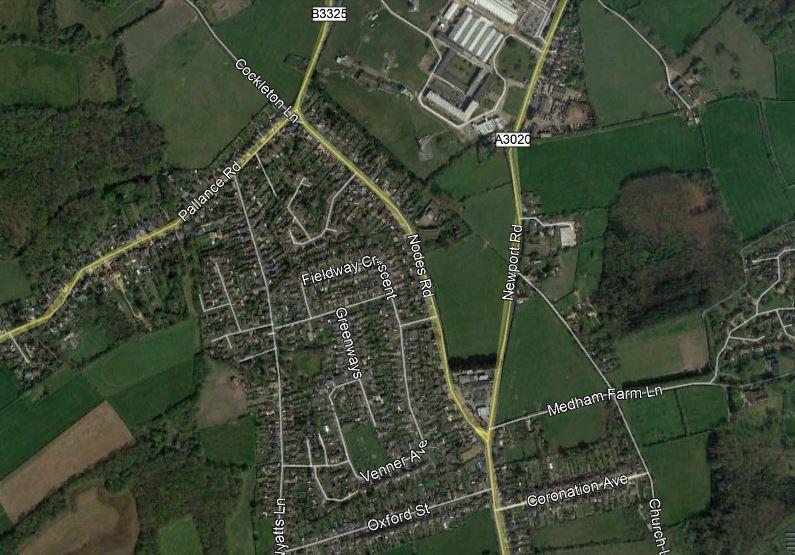

• The results of the Place Plan consultation indicate a desire to see better management of shared-use areas for pedestrians and cyclists in Cowes, and better infrastructure, management and waymarking of through routes and key destinations as a whole.
• Cowes Town Council is already considering the use of traffic orders to trial cycling in the High Street; this provides a useful platform from which to extend the review to cover related and connected issues arising from the Place Plan consultation:
o Greater clarity and direction for cyclists, making use of the local, regional and national routes that pass through the town, with particular attention to the Arctic Road access to and from Route 23 where there is an opportunity to create an information and orientation point.
o Clear demarcation of ‘gateway’ access from the High Street to the waterfront, with both interpretation and information provided to explain and manage pedestrian movement within a working environment, identifying key viewpoints and building greater everyday contact between visitors and harbour.
o Investment in essential but currently missing infrastructure (such as road crossings) that make these routes safe options for active travel. Without this critical investment, waymarking and orientation cannot deliver the improvements for pedestrian and cycle permeability demanded by the local community.
• In order to clarify waymarking and encourage pedestrian and cycle transit into and across the town centre there needs to be consistent orientation given at critical junctions and these in turn must be supported by the physical infrastructure needed to make them safe and useable. The following are options based on consultation feedback and the Cycling Strategy for the Isle of Wight, but it is strongly recommended that a Local Cycling and Walking Infrastructure Plan (LCWIP) be produced for Cowes and Northwood, and preferably for the Medina Valley as a whole, as has been done for Newport and Ryde. It will also be essential to align new permeability work with the proposals for the England Coastal Path.
o The Arctic Road junction with National Cycleway 23 – rationalise existing information, infrastructure and waymarking to create a more coherent directional location.
o Junction of Bridge Road and Arctic Road. Incorporate Arctic Park and the wider ‘deconstructed’ park network both through direction and safe access infrastructure.
o Junction of Birmingham Road and Medina Road.
o Junction of Beckford Road and Birmingham Road (incorporating the small square around the clock).
o Fountain Quay: this is a very important transit space and town square. The need (and opportunity) to free it from the clutter of public and private transport and expand the street café , waterfront access and civic space functions is recognised in the consultation feedback. The proximity of the Harbour office with its own public frontage creates additional scope for community engagement.
Fountain Quay and waterfront

Potential Permeability
Investment
Priorities between Cyclepath and High Street
Beckford Road/Birmingham Road incorporating seating areas
Birmingham Road/Medina Road
Bridge Road/Arctic Road incorporating Arctic Park
The exit/entrance to the cycletrack gateway space
• The Place Plan feedback was positive on the existing availability of accessible open space, especially so with regard to Northwood Park, which is greatly valued and well used and similarly Mornington Woods, an important local greenspace providing local people with access to nature.
• Consultation responses also showed however that the appeal of headline greenspace, such as Northwood Park, is not universal and that there are parts of the Cowes community for which they are not first choice.
• In the south and east of the town there is a need to facilitate the use of a band of smaller greens and parks between Park Road, Place Road and Newport Road, that currently exist as disconnected spaces and are thus more vulnerable to funding and maintenance stresses. These four areas are:
o IW Community Club and adjacent Recreation Ground
o The informal greenspaces around Lanesend Primary school (including the small public woodland linking Seaview Road and Highfield Road)
o The greens, verges and informal spaces around Fraser Close, Nelson Drive and Arctic Road (connecting with Northwood Cemetery and the cycleway woodlands). Here, as elsewhere in Cowes, there are significant areas of orphan land left bona vacantia by dissolved manco and developer agreements.
o Three greens grouped around the Victoria Road/Mill Hill Road junction: Moorgreen Allotments, St. Mary’s Road and Arctic Park.
• By taking a lead in bringing together the land management organizations responsible for these areas (potentially linking with the work of the Resilience Group), Cowes Town Council can positively intervene to encourage use individually and collectively.
• The sites lend themselves to a waymarked ‘southern circuit’, using short cuts and pedestrian routes away from the main roads, bringing people into contact with lesser-known areas of their neighbourhood and increasing opportunities and prompts for outdoor recreation. This is a second major orientation project to run alongside the cycleway/waterfront work.
• By considering these sites together, the town council also creates new opportunities to further develop two important areas of its work, i) its adoption of bona vacantia land, and assistance to local residents, volunteers and landowners in securing temporary or permanent improvements for public amenity in these places; ii) its continuing support for a local tree warden service and annual efforts to promote new planting, particularly orchard varieties (linked to the Incredible Edible campaign). A signature approach to orphan land using orchard tree species, for example, supports community, biodiversity and amenity objectives.
• Encouraging local circulation between open spaces, greens and ‘doorstep’ amenities also increases the likelihood of positive meetings between local organizations (cemetery, allotments, food bank etc) and the neighbourhood that they share.





• There is a strongly defined and well-used cluster of sports and recreational facilities at the junction of Place Road and Park Road all of which are in public ownership. This sits at one end of the ‘southern circuit’ of public and community open spaces. There is a natural extension of this hub to the north, taking in the golf course and the academy sports fields as semi-public spaces with the potential to engage in wider community benefit.
• The IW Community Club, Recreation Ground, MUGA and skatepark create a 10 ha block including the model boating lake managed by the IW Model Engineering Society. There is also close proximity with the playing fields at Lanesend Primary and also with the WightTricks teaching academy on the Prospect Road industrial estate.
• The variety of recreational activities, informal and organised, with open greenspace, natural landscaping, circuit walks and wildlife interest make this a very significant resource that would benefit from an integrated approach to sport, recreation and active travel between the group of landowners, tenant and maintenance organizations.
• Given the extent of the new housing development proposed and permitted along Place Road, the case for s106 contributions to the sports hub from local planning applications seems inarguable, recognising the essential amenities that it provides to these new communities and supporting essential infrastructure such as more and better crossings on Place Road and Park Road.
Extended hub to include semi-public spaces, golf course and school fields
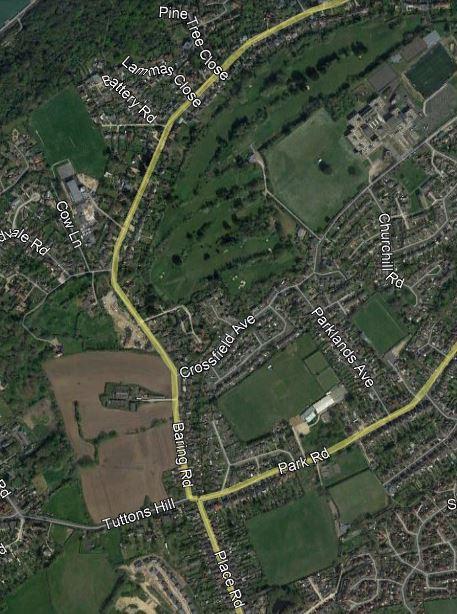

Main public sports and recreation hub

• 25 Ha of industrial, employment and retail land runs from The Range and Prospect Road in the west to Manners Way in the east. The component sites are almost contiguous, creating a distinctive and substantial urban business zone stitching together the parishes of Cowes and Northwood along the line of Three Gates Road.
• An additional 25 Ha of BAE and Rangefinder campus with the small business cluster at Northwood Garage adds a second zone, less public but significant for the scale and profile of its main companies. This extended zone features now well-established agreements between the Isle of Wight Council, BAE and Ascensos and plans for the extension of these through the Innovation Wight centre. There is therefore a strong precedent in place to continue to develop and extend a public/private approach to local economic projects. The scope for such a collaborative approach to employment and enterprise is increased by the council ownership of the Somerton Industrial Estate and the adjacent Park and Ride site.
• Northwood Parish Council and Cowes Town Council are in a position to work together with IW Council and Cowes Business Association to more directly influence and participate in economic activity and investment across the business park areas. This approach fits well with the sharing economy model for example by taking on vacant units and reletting at affordable rates and on flexible terms to support local start-ups, spin-offs from existing businesses (tech and other) and social enterprise incubators.
• Directional and arrival signage for these areas is poor or absent, a point made by local businesses in the 2018 Northwood Business Survey. There is an opportunity to pull these areas together under a coherent brand identity, signposting access, routes through, businesses present, rentals and on-site business opportunity and recruitment, permeability on foot and by bike, nearby public and community amenities; all of this tying in the whole enterprise zone to its neighbourhood, building identity and appeal and increasing footfall.
• Finding a way to connect through from the Prospect Road to Seaview Road via public footpath 7 would help pedestrian and cycle options for navigation across the estates. By increasing the possibilities for encounter between local residents, local workforce, local business and community activity, the likelihood of useful and productive economic activity is boosted.
• There is an opportunity for Northwood and Cowes councils with the business association, to work with the IW Active Travel team and create a stronger node of public transport for local companies. Better walking and cycling access, building on the existing Park and Ride facilities, safe and wellpositioned road crossings, waymarked links to the National cycleway and England Coastal Path, clear orientation points into Cowes away from main roads and investing in essential active travel infrastructure will improve the appeal, productivity, identity and local integration of the enterprise zones.
Principal Enterprise Zone with full public access


Extended Enterprise Zone with restricted access

Cowes Town Council to lead on bringing together the four parishes (and Gurnard if requested) with key waterfront sites in the estuary to create a North Medina Forum. The objective is to build a more influential lobbying voice for the shared interests of the bloc:
o Investment from the Solent LEP via the Solent 2050 industrial strategy and benefits arising from the Solent Freeport.
o Coordinated and mutually beneficial management of the Isle of Wight Council and the Solent LEP freehold and leasehold estate concentrated in the North Medina.
o A single, coherent masterplan for the harbour and working estuary defined through Local Development Order or similar framework in the draft Island Plan.
o A STEM centre of excellence with regional industry-research partnerships and edutainment space.
o A port identity that combines strong local social impact with natural environment and ‘greentech’ specialism and educational tourism attractions creating a distinctive offer to all customers and users aligned with the UN Sustainable Development Goals and the IW UNESCO Biosphere.
o Involvement in the planning and delivery of current and future Medina crossings,
o Agreement with the Isle of Wight Council and Island Roads by MOU or public performance agreement, to prevent serious disruption to local quality of life as a consequence of uncoordinated highways and utility works.
• Cowes Town Council to lead on bringing together the 15+ core social purpose and non-profit organizations in the Place Plan area to create a Resilience Group based on a civic college model and designed to build a self-sufficient network of service providers, supply chains and social enterprise.
• This collegiate approach to resources, premises, projects and funding can function through regular meetings as a ‘resilience board’ and through the collaborations and partnerships that emerge from a better understanding between the constituent organizations.
• Key objectives include:
o Building a sharing economy model between civic organizations to strengthen services to the communities of Cowes and Northwood.
o Work with IW Public Health, Community Action IW, NHS Integrated Locality, CCG and Cowes Medical Centre to enable local commissioning and ‘wellbeing’ investment through social prescribing.
o Work with Cowes Business Association to bring closer together the non-profit/3rd sector and the private sector to strengthen local partnerships and procurement.
o Extend shared facilities to support marine industry ‘campus’ within the North Medina masterplan.
o Lobby the Isle of Wight Council for further asset transfer to local operators from the public register.
• Cowes Town Council and Northwood Parish Council to develop Local Network Plans designed to deliver safe pedestrian and cycle access to, and between, priority public and commercial spaces and manage centres of local interest to increase the community value and benefit.
• Both councils to work with the business association and the Isle of Wight Council to develop a coherent identity for the set of business parks running along their shared boundary to create an overall Enterprise Zone including:
o Branding and marketing.
o Commuting options prioritising public transport, cycling and walking.
o Easy access into and between business parks.
o Access and information sharing between the Enterprise Zone and its neighbouring community spaces and places.
o Build on the strong local public influence as local landowner (e.g. Somerton) and investor (e.g. Rangefinder) by playing an active role in the acquisition and occupation of ‘social purpose’ business space within the estate.
• Northwood Parish Council priorities:
o Bringing together the four existing community open spaces to strengthen and expand options and opportunities for recreational provision in the village centre.
o Agree a set of local planning principles with the Isle of Wight Council (through SPD or MOU for example) to ensure that i) new development contains adequate public space connected to the existing network, and ii) s106 is fully applied to enhancing open space provision across the village and securing urgent highway safety improvements that connect them.
o Prioritise improved pavements and road crossings on Pallance Road, Newport Road, Nodes Road, and Three Gates Road.
o Work as a community land trust, investing in new and extended public facilities (such as community centre/indoor spaces) and expanding public access to open space for recreation through partnership with local landowners (such as BAE).
• Cowes Town Council priorities:
o Waymarking and orientation points with additional infrastructure for safe crossings between the Arctic Road access to Route 23 and the Esplanade via the High Street, including clear routes into the waterfront and changed priorities for Fountain Quay, aligning with proposals for the England Coastal Path.
o Bring together the management and waymarking of the ‘southern belt’ of greens, parks and open spaces to create a coherent, navigable network with active involvement in environmental and ecological enhancements, providing an alternative/addition to Northwood House grounds for recreation.
o Invest in facilities, access and branding for sports and recreation hub, coordinating management across the 10 ha site for maximum local impact, supported by s106 from Place Road developments (and other qualifying schemes).
o Commission a Local Cycling and Walking Infrastructure Plan for the whole Place Plan area.
The Cowes and Northwood Place Plan sets out three key measures to take forward priorities for positive change.
The North Medina Forum will establish a single, coherent voice for the four communities that define the harbour and its working estuary.
The Resilience Group will create a new local framework of social and civic organizations covering health, wellbeing, economy, education and environment, sharing resources and boosting local self-sufficiency.
The Local Network Plans will identify key areas to invest in and improve permeability and safe access and active travel between clusters of improved facilities for public amenity, recreation and employment.
The Place Plan is designed to be a workbook. It sets out evidence and recommends rapid action, but is also arranged in such a way that local stakeholders, residents and businesses can follow up other lines of interest from any part of the report, adapt and improve priorities from the platform that the plan provides, and generate new ideas for a better future from the raw materials that it brings together.
The Place Plan uses the Shaping Better Places methodology to design its projects and programmes and this is summarised and appended for general use.


